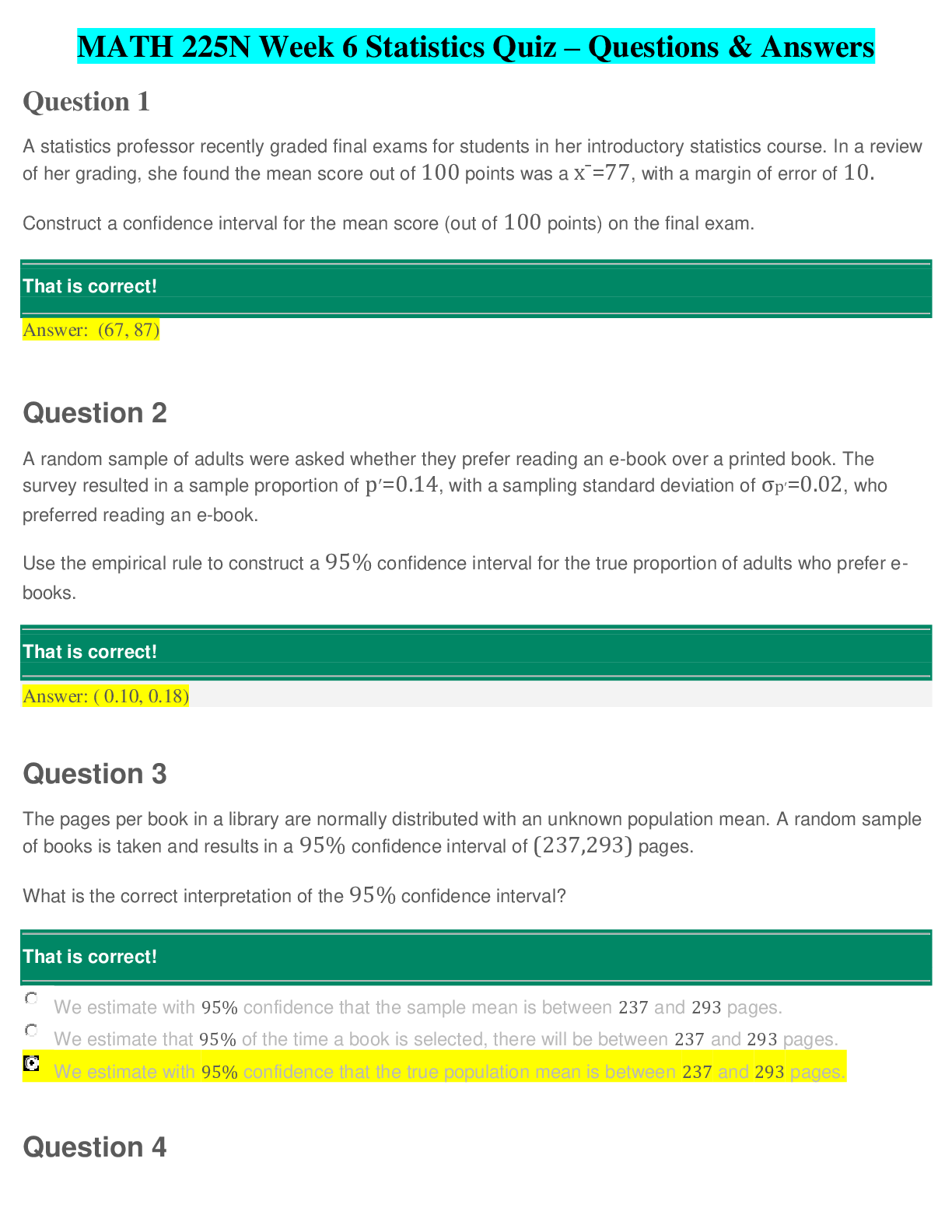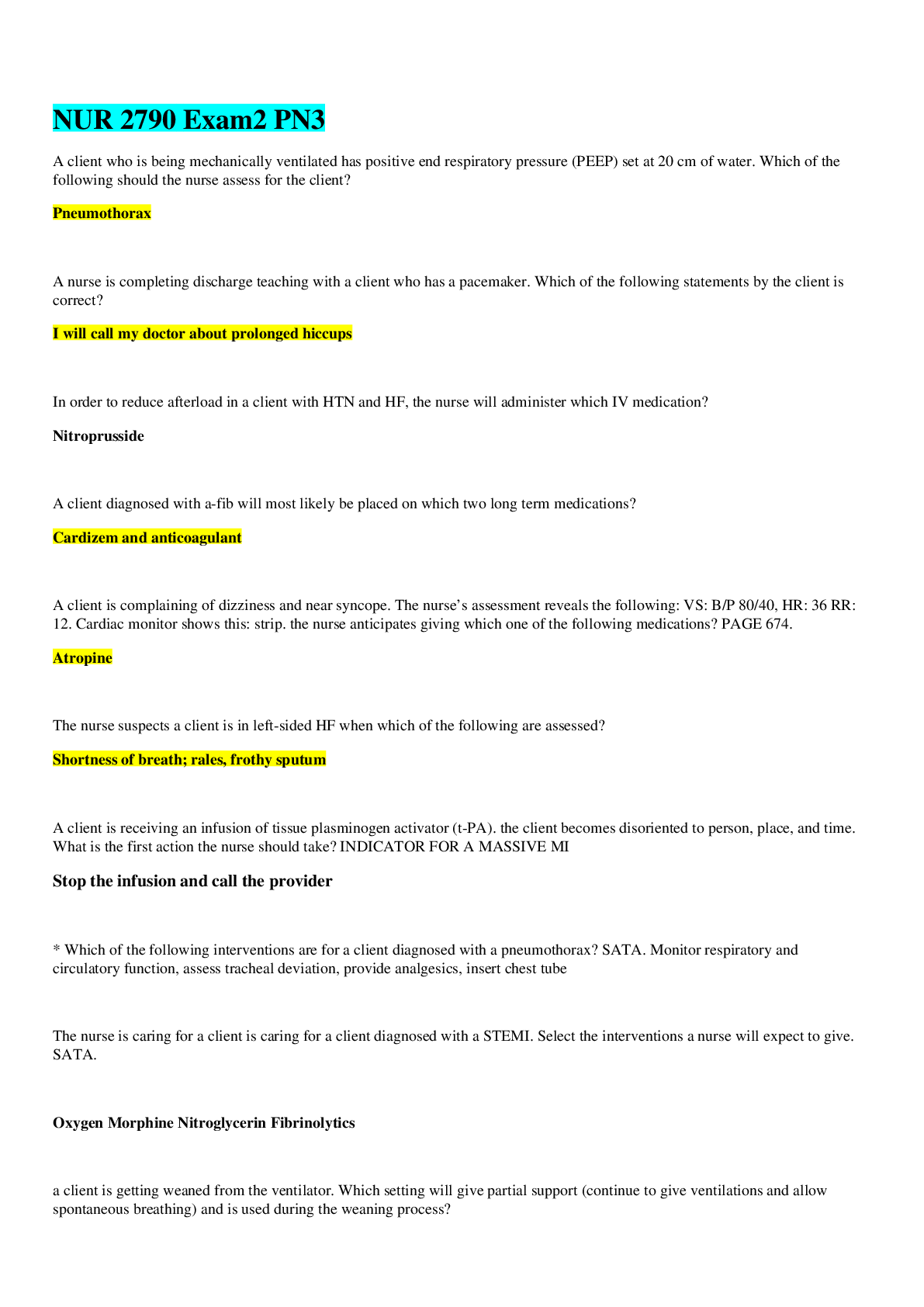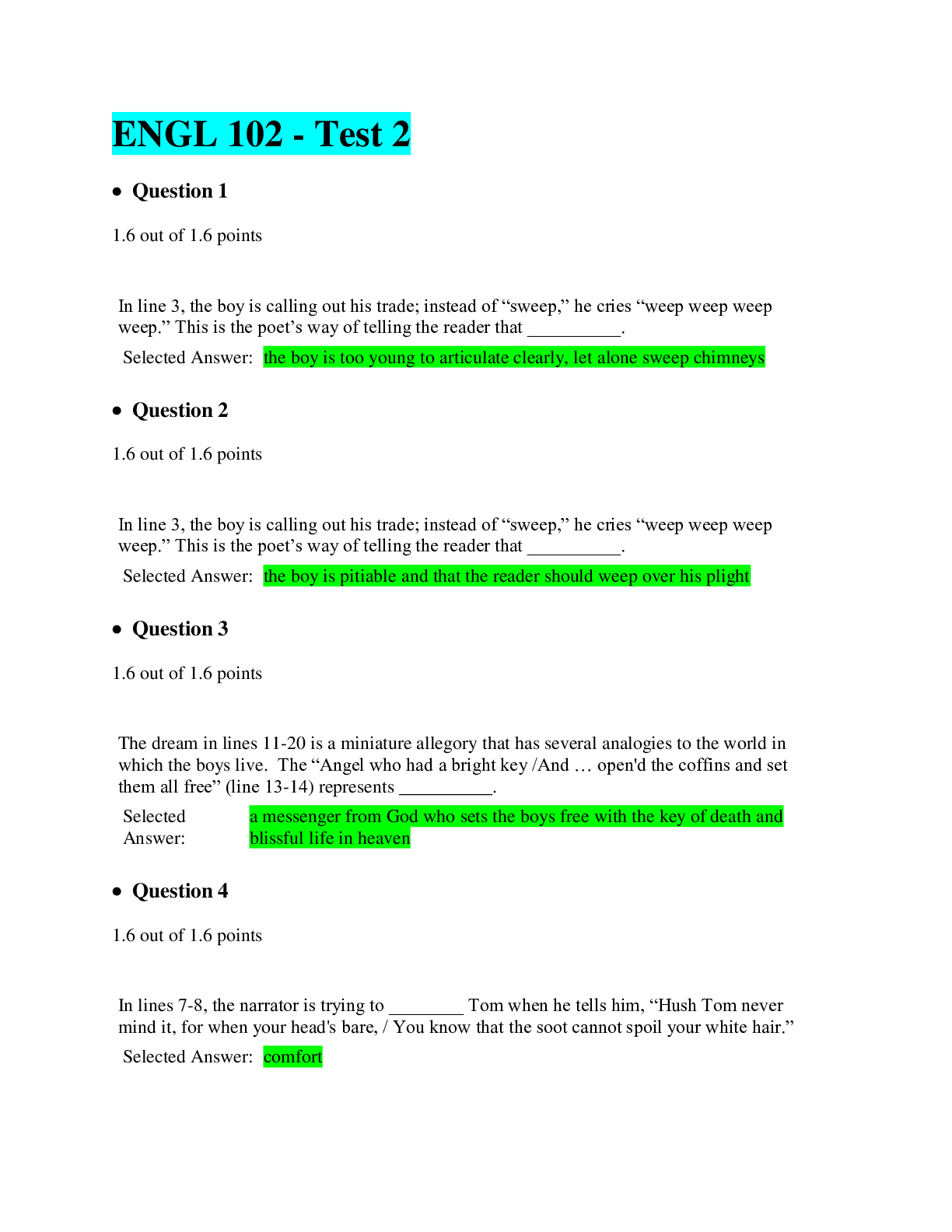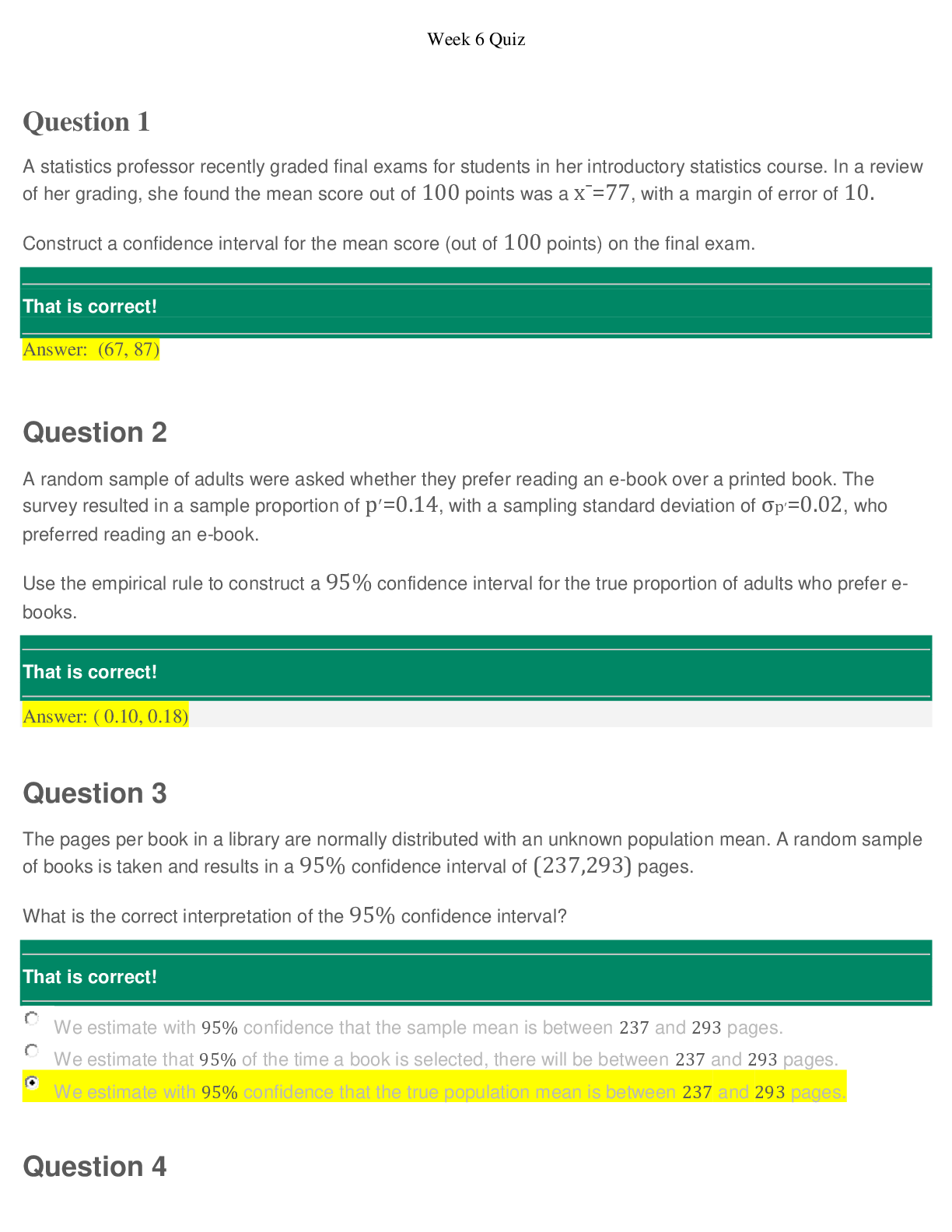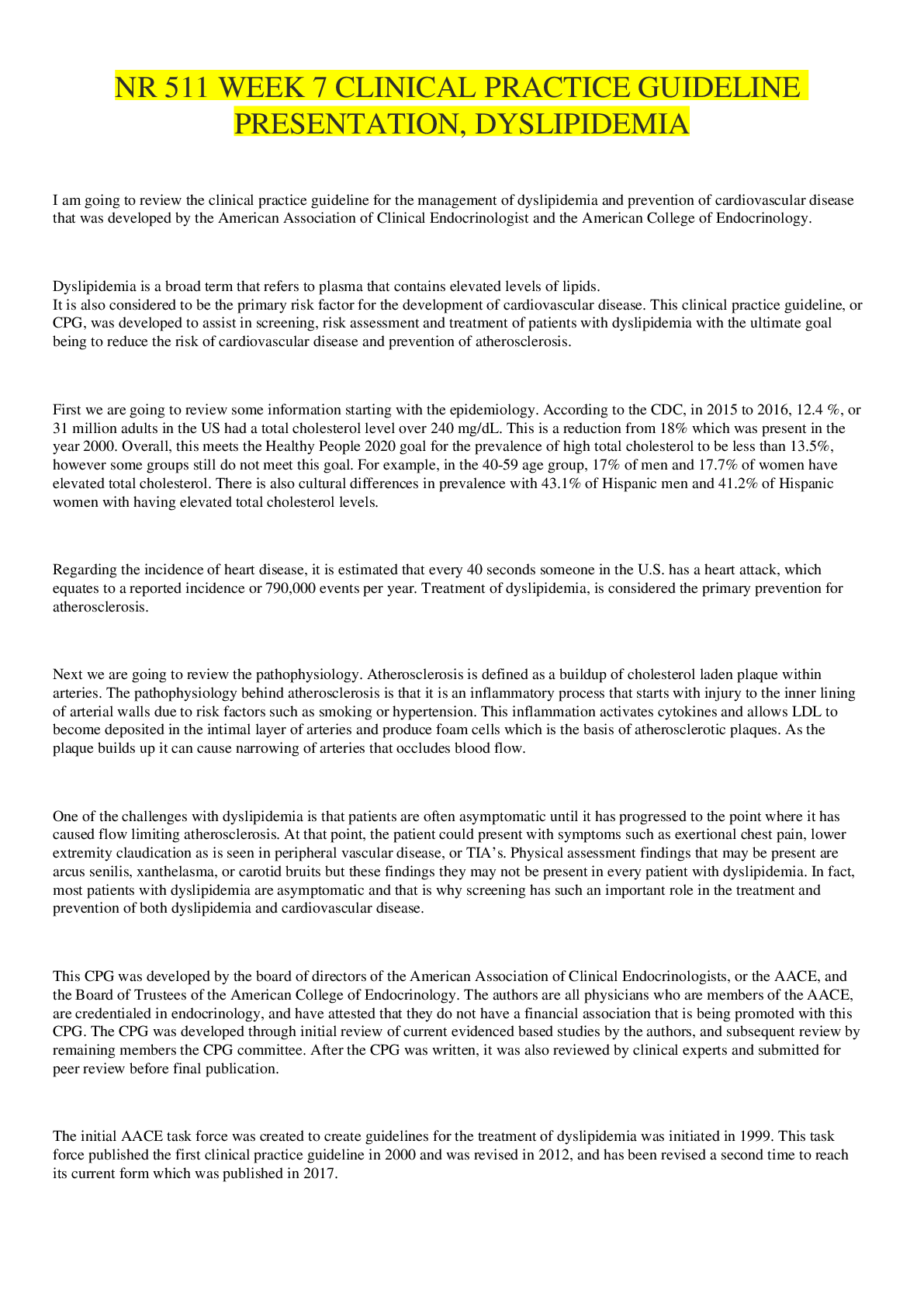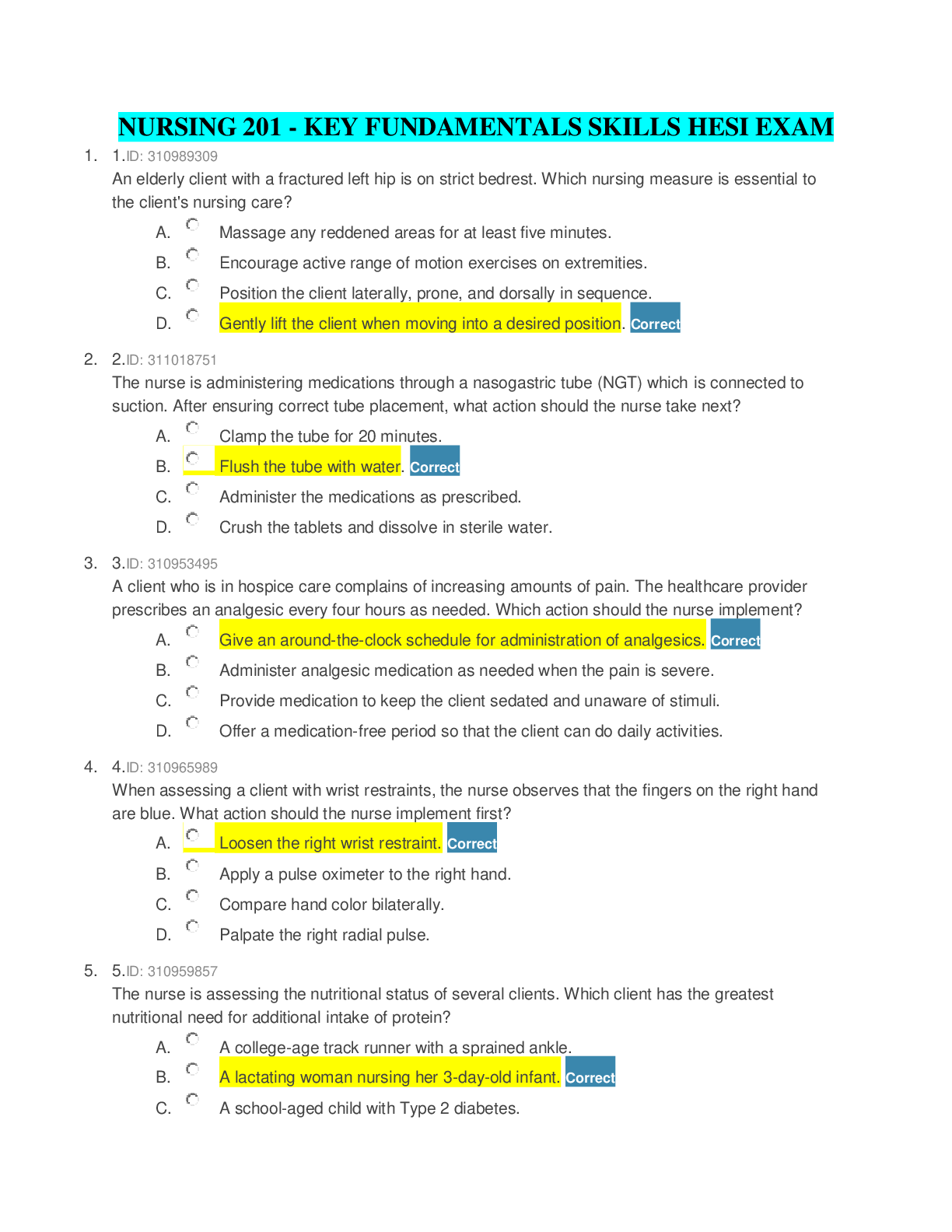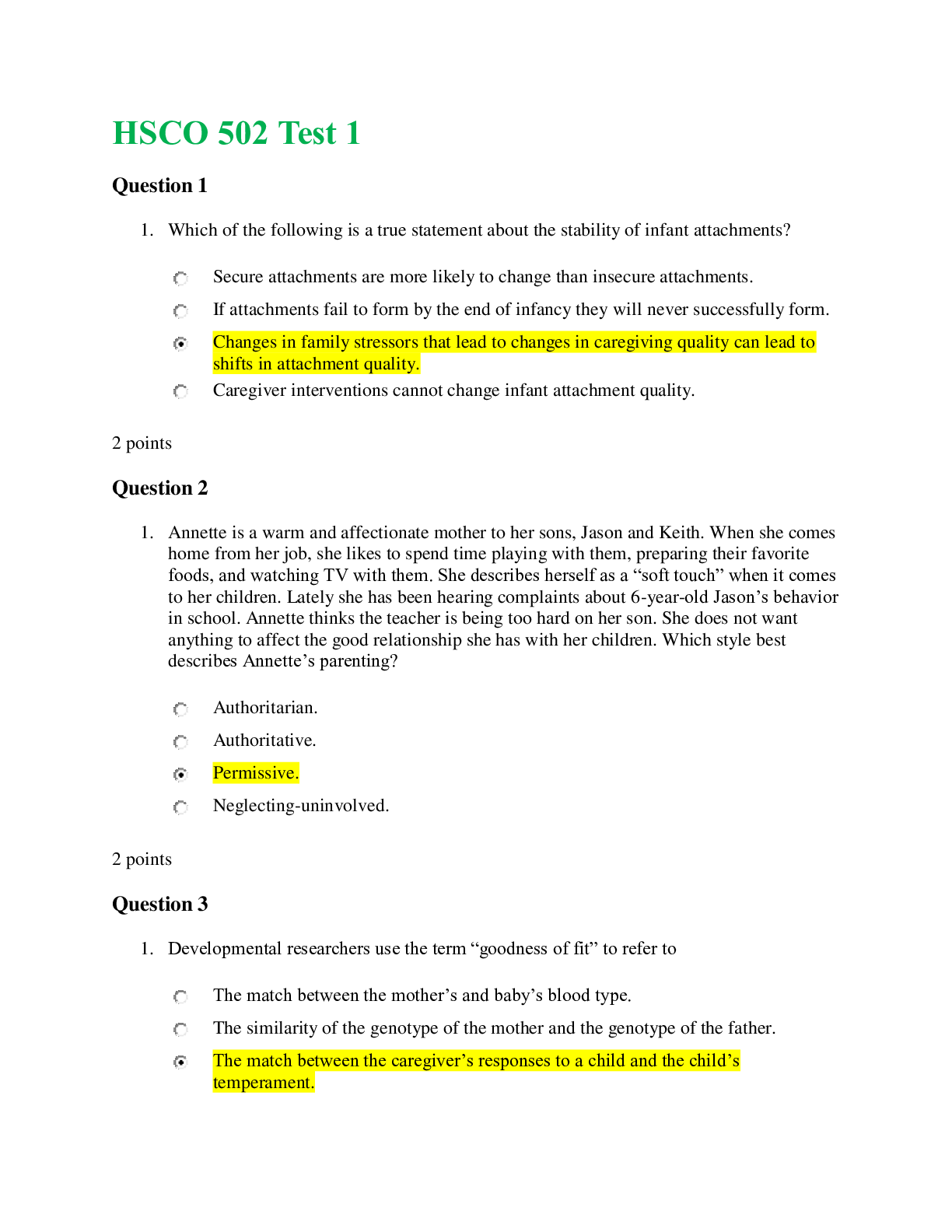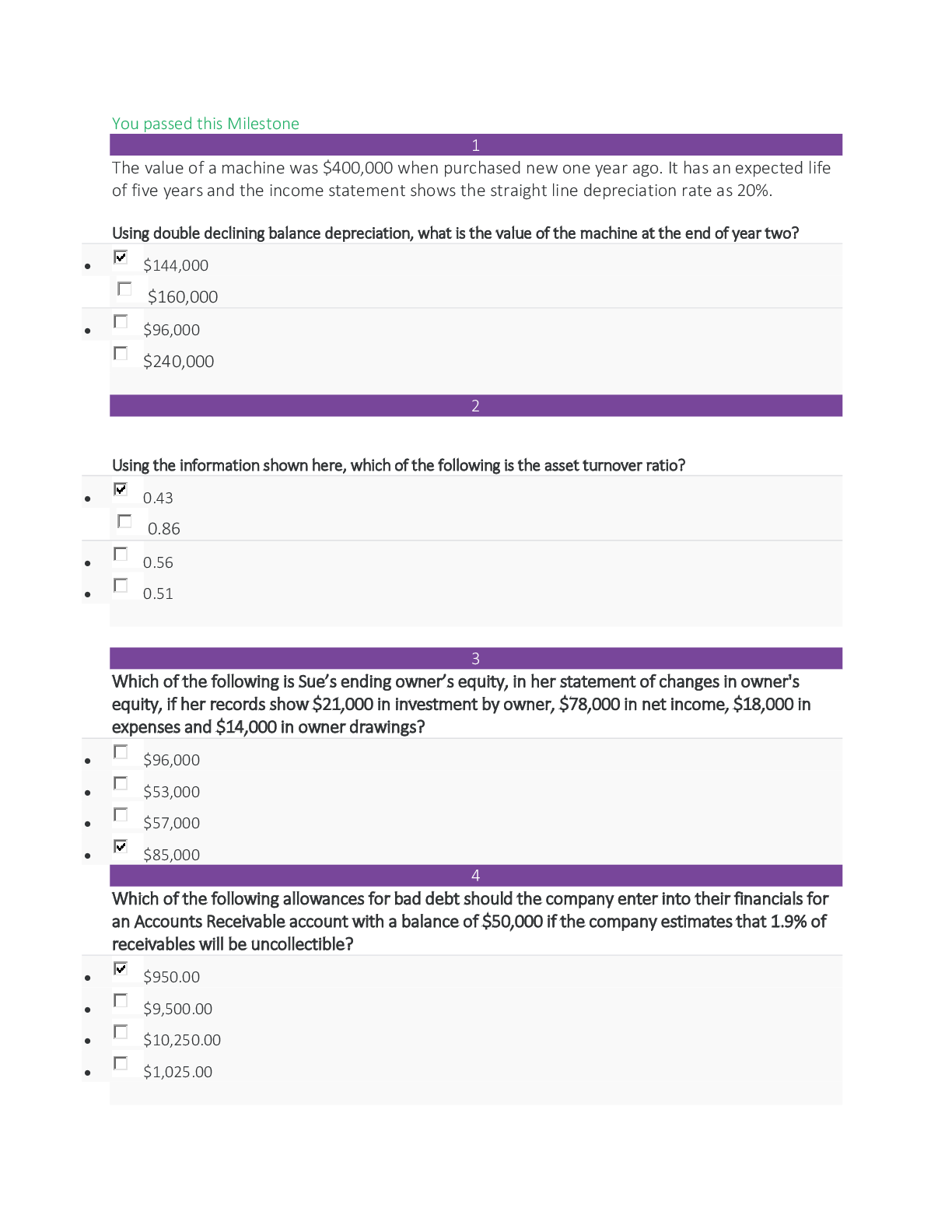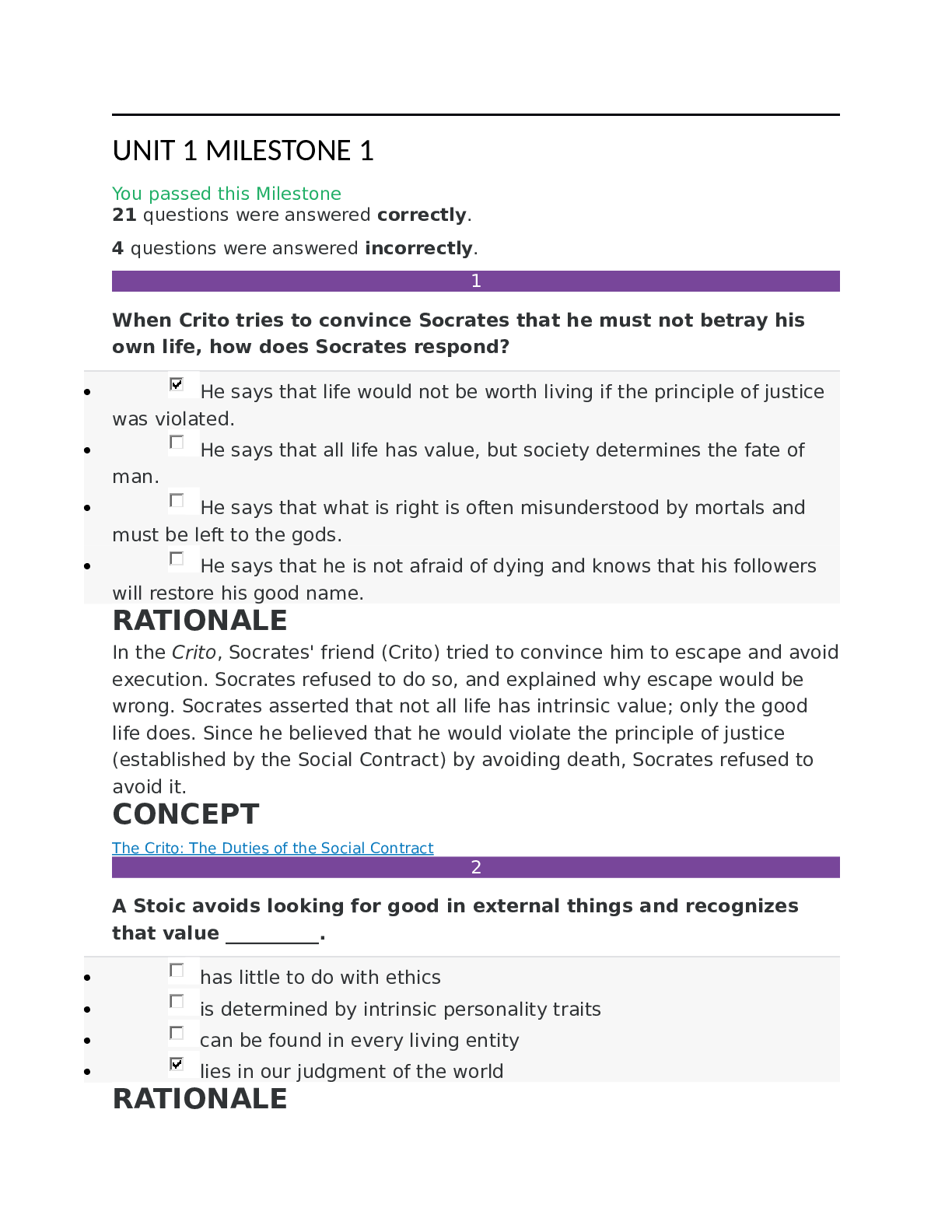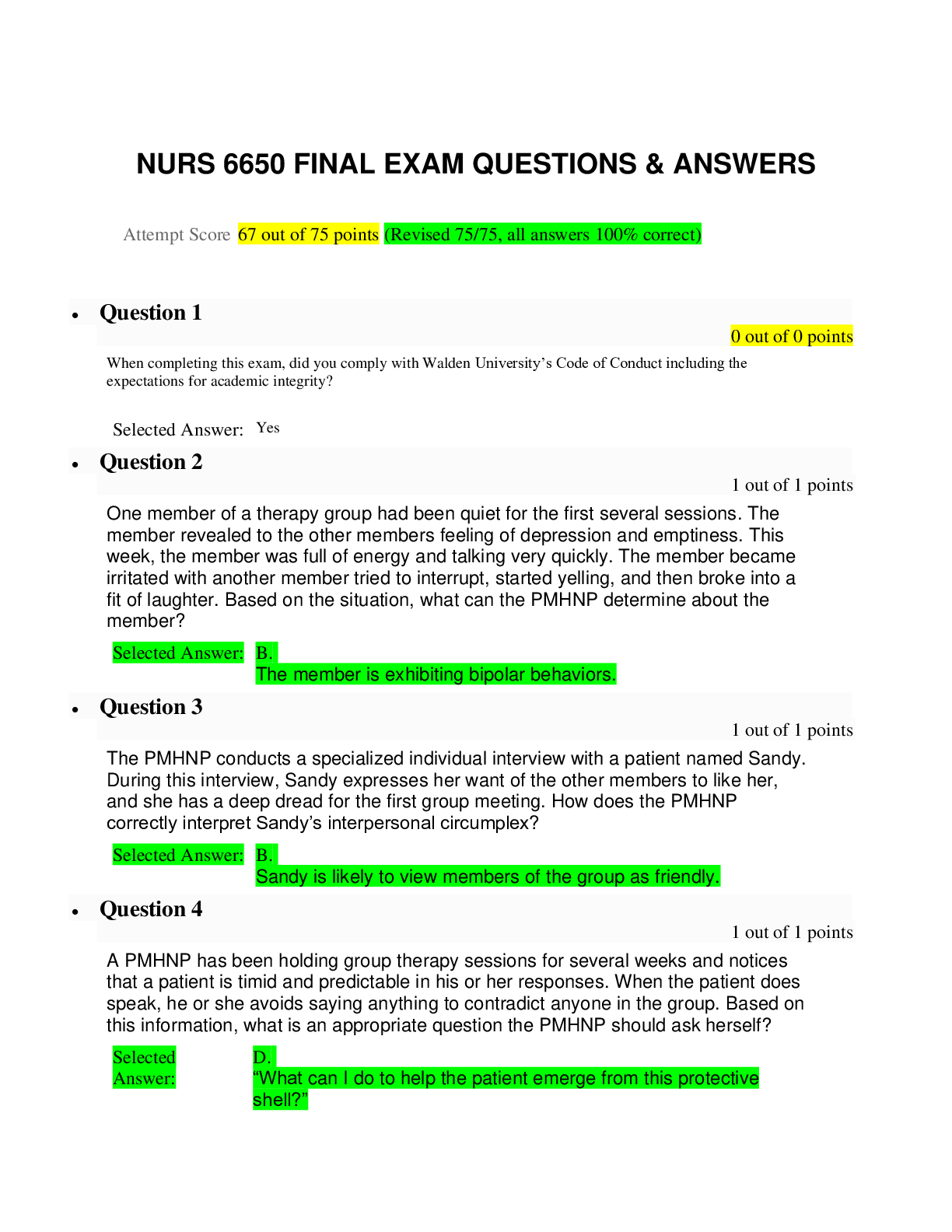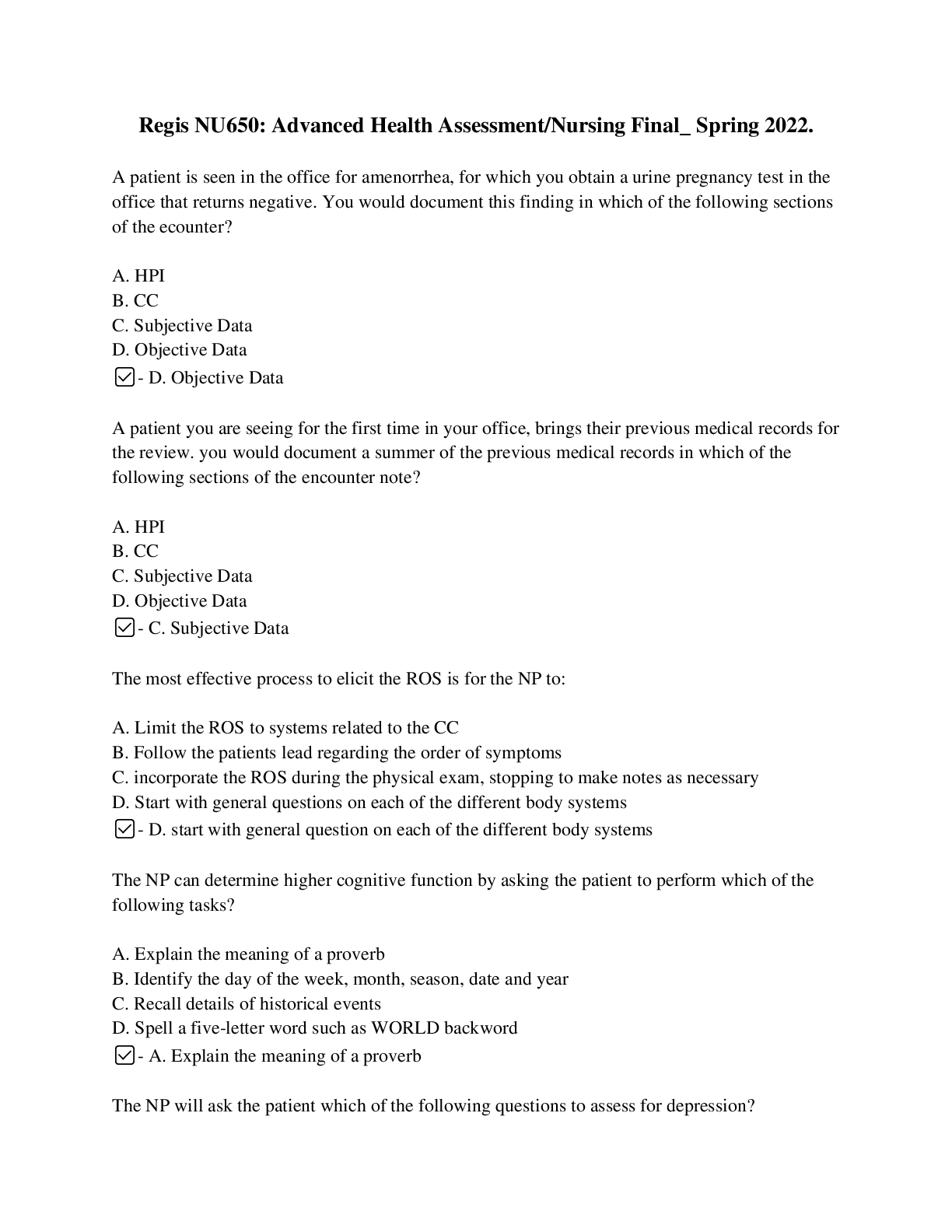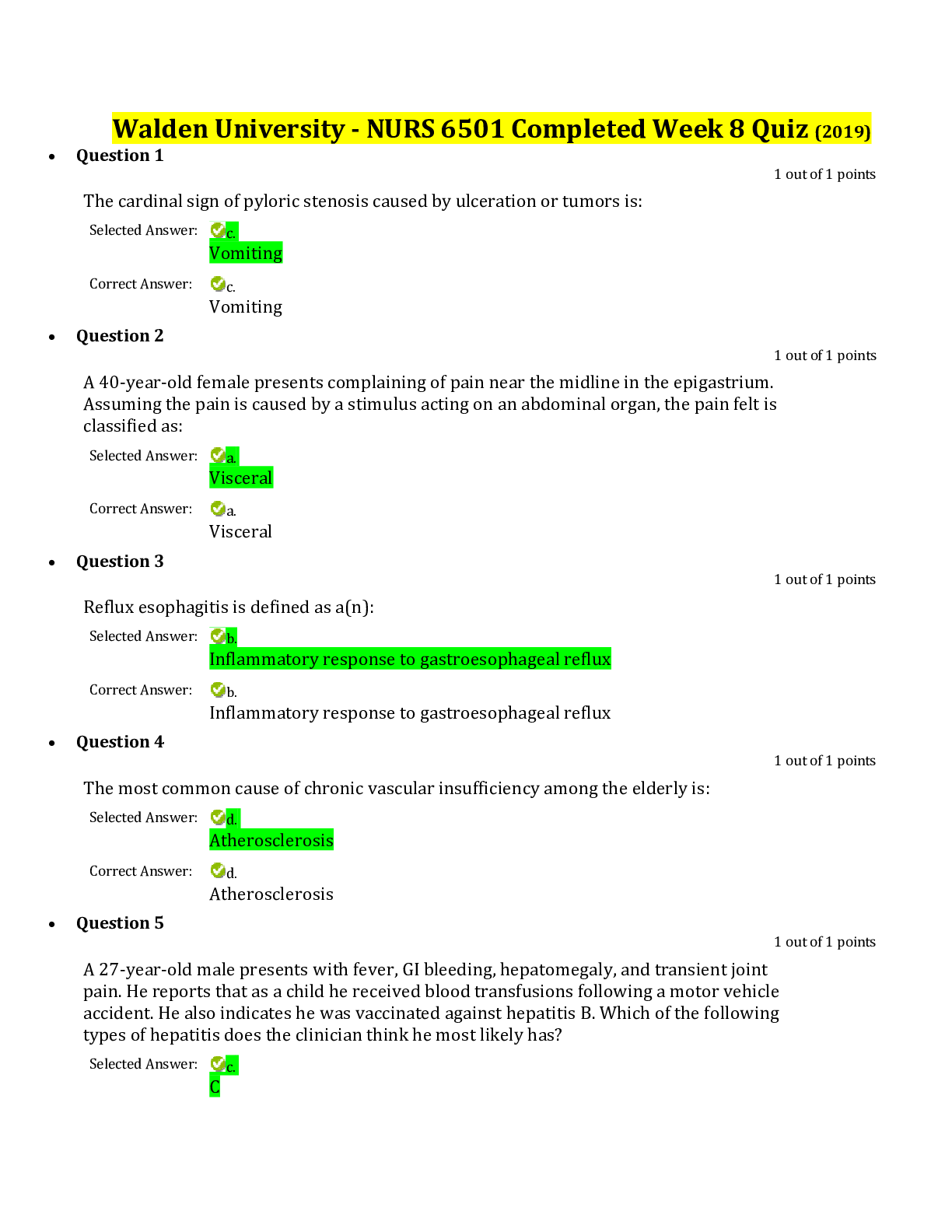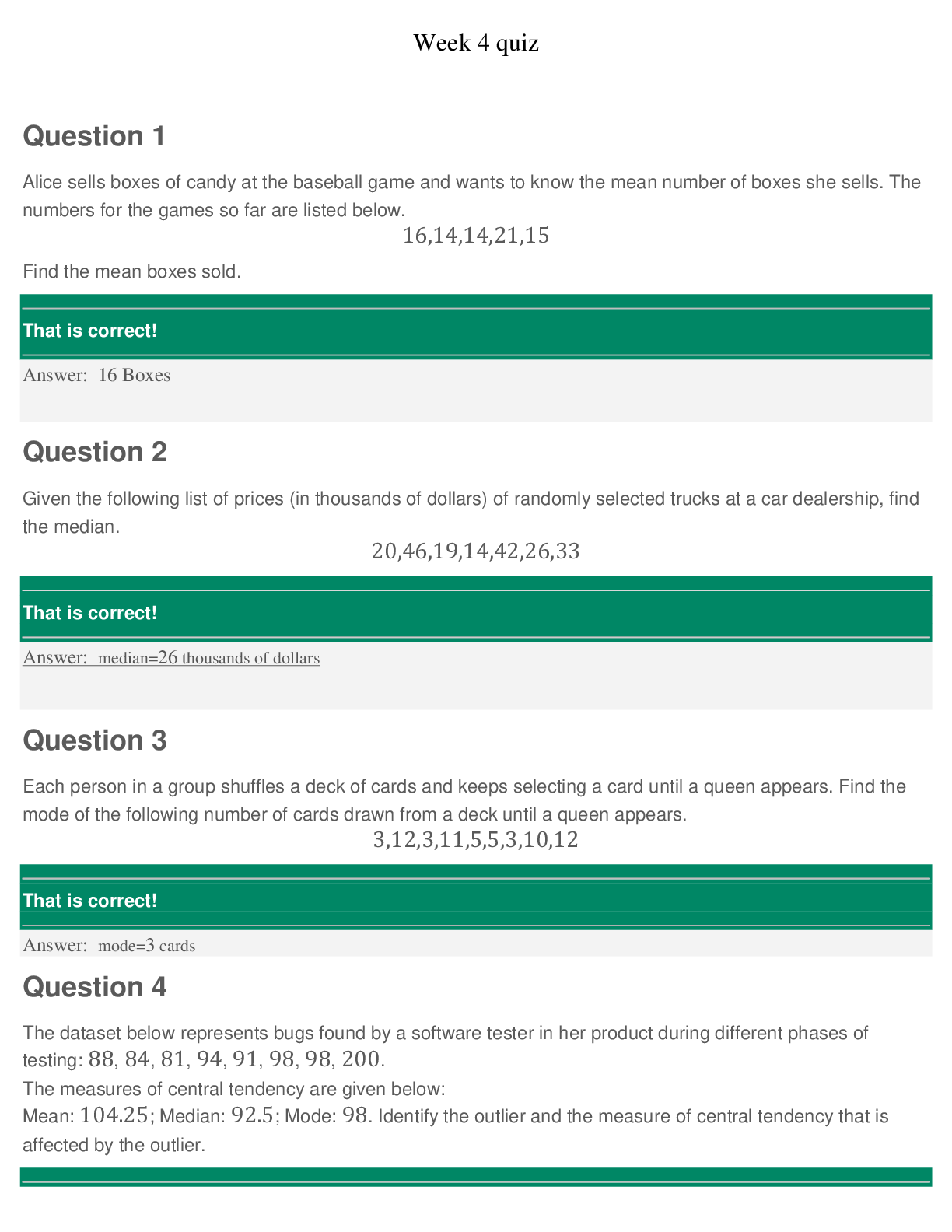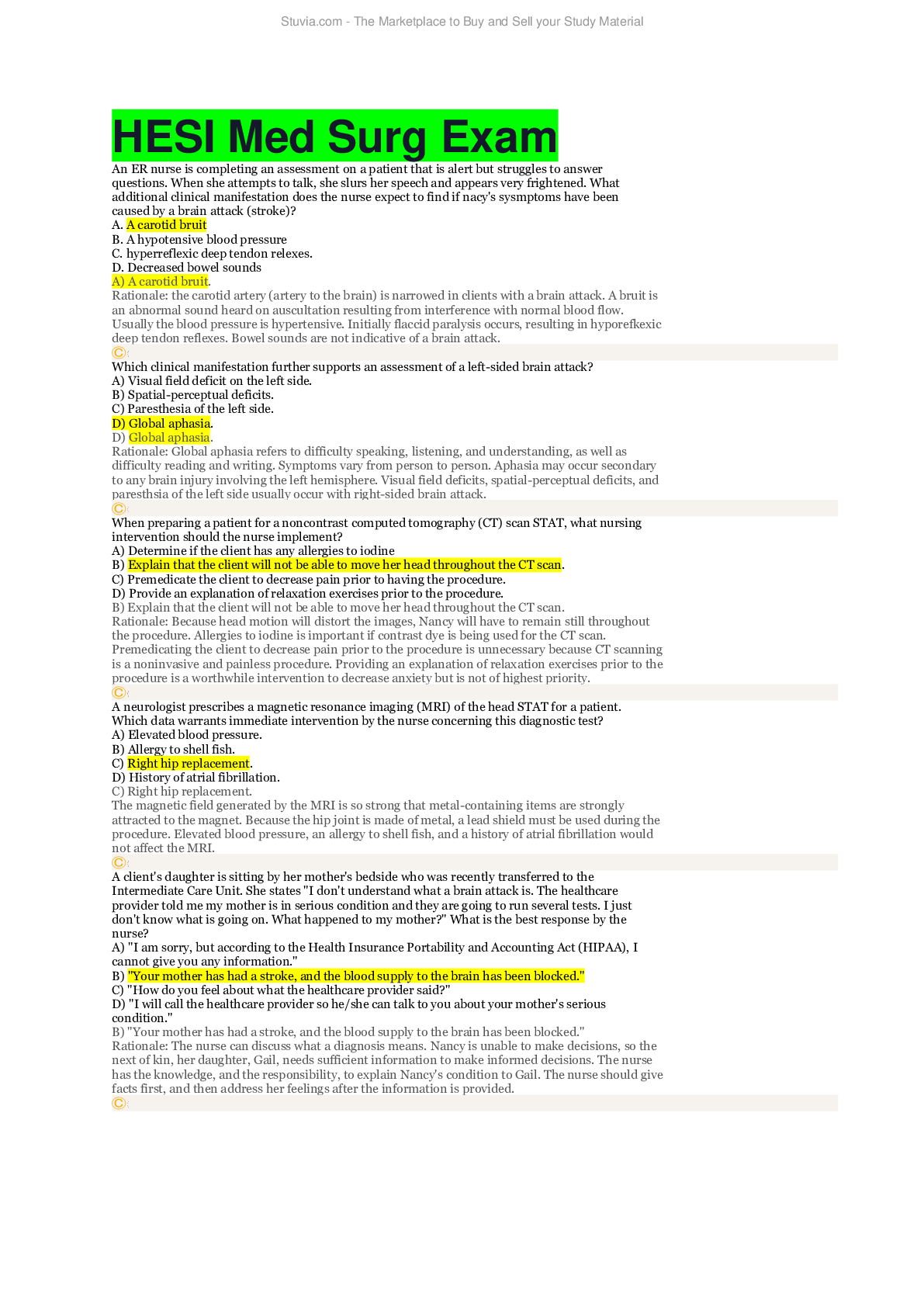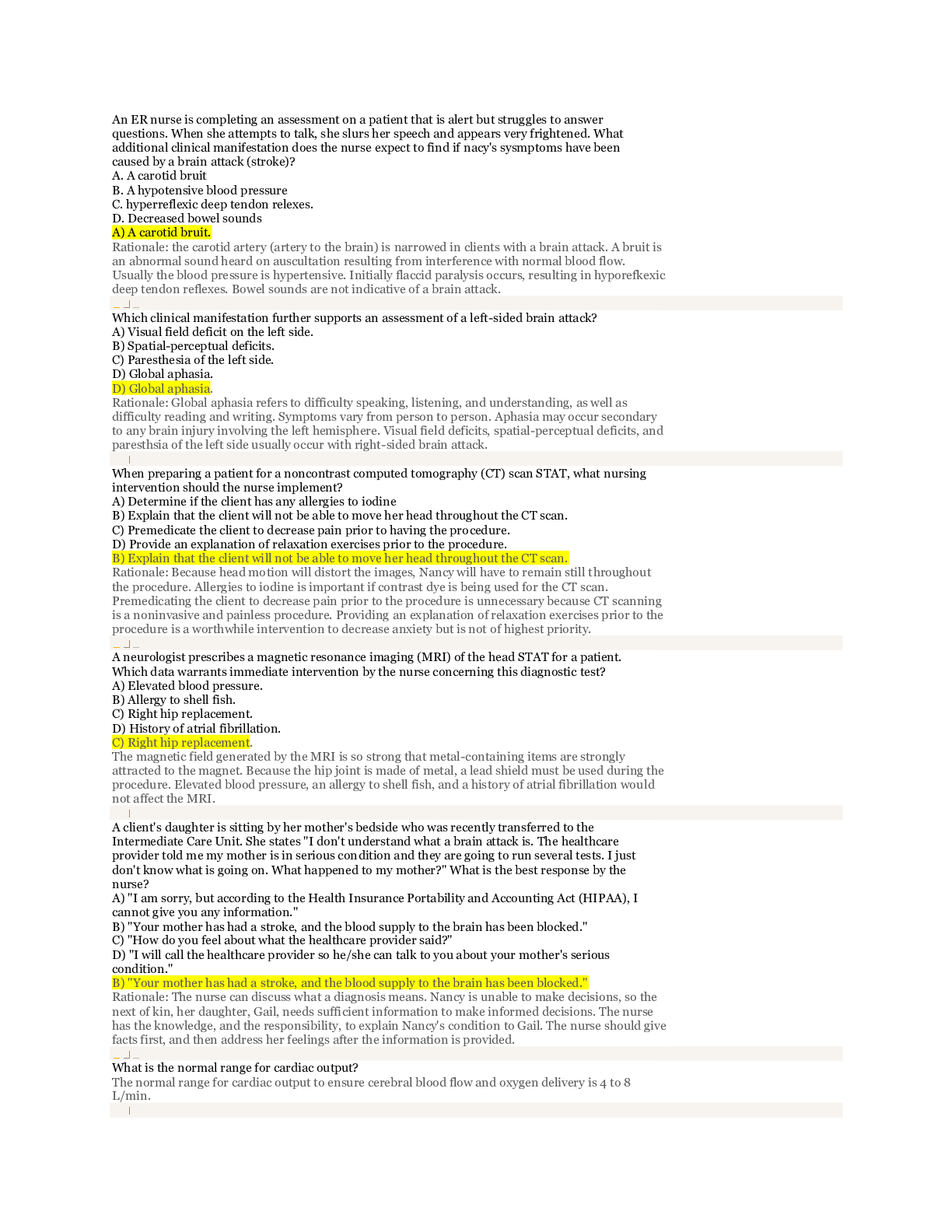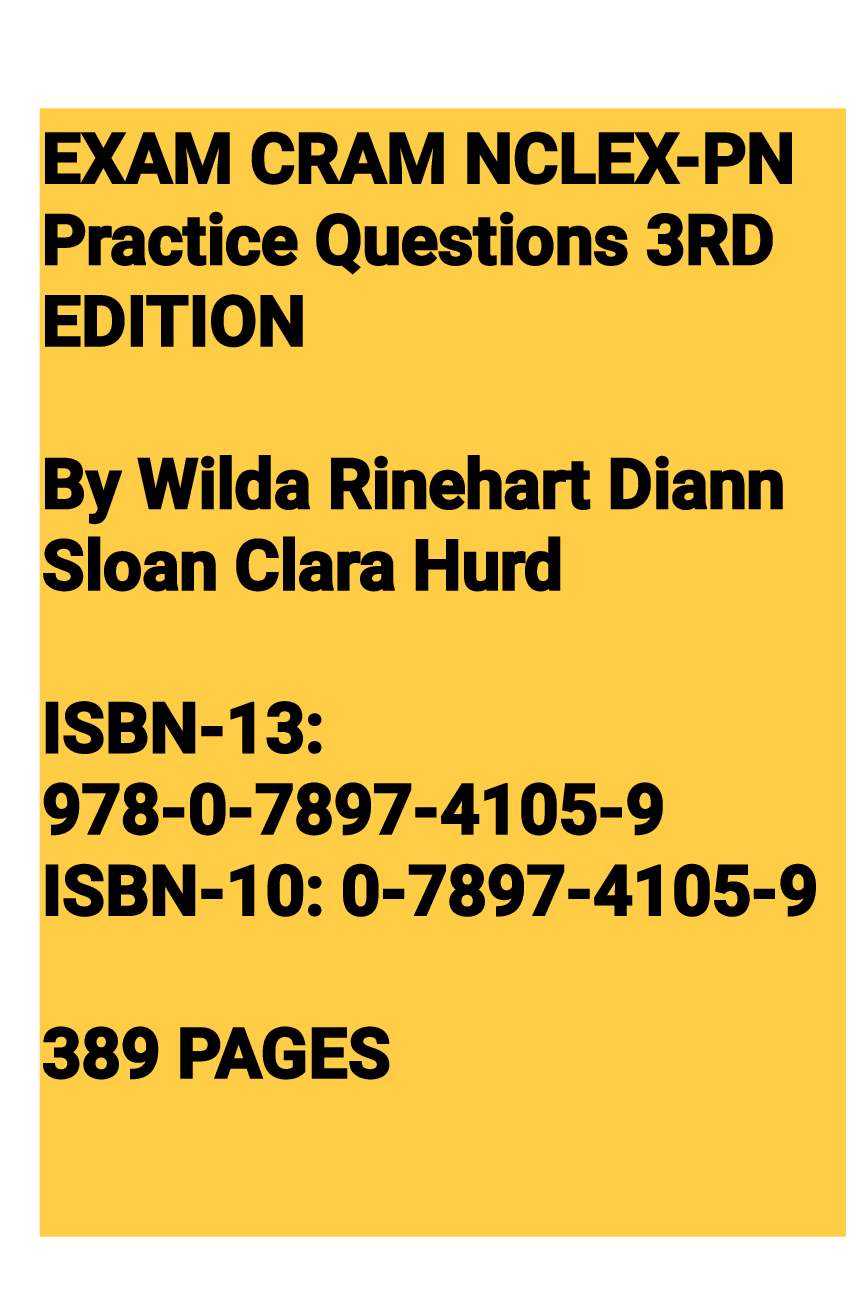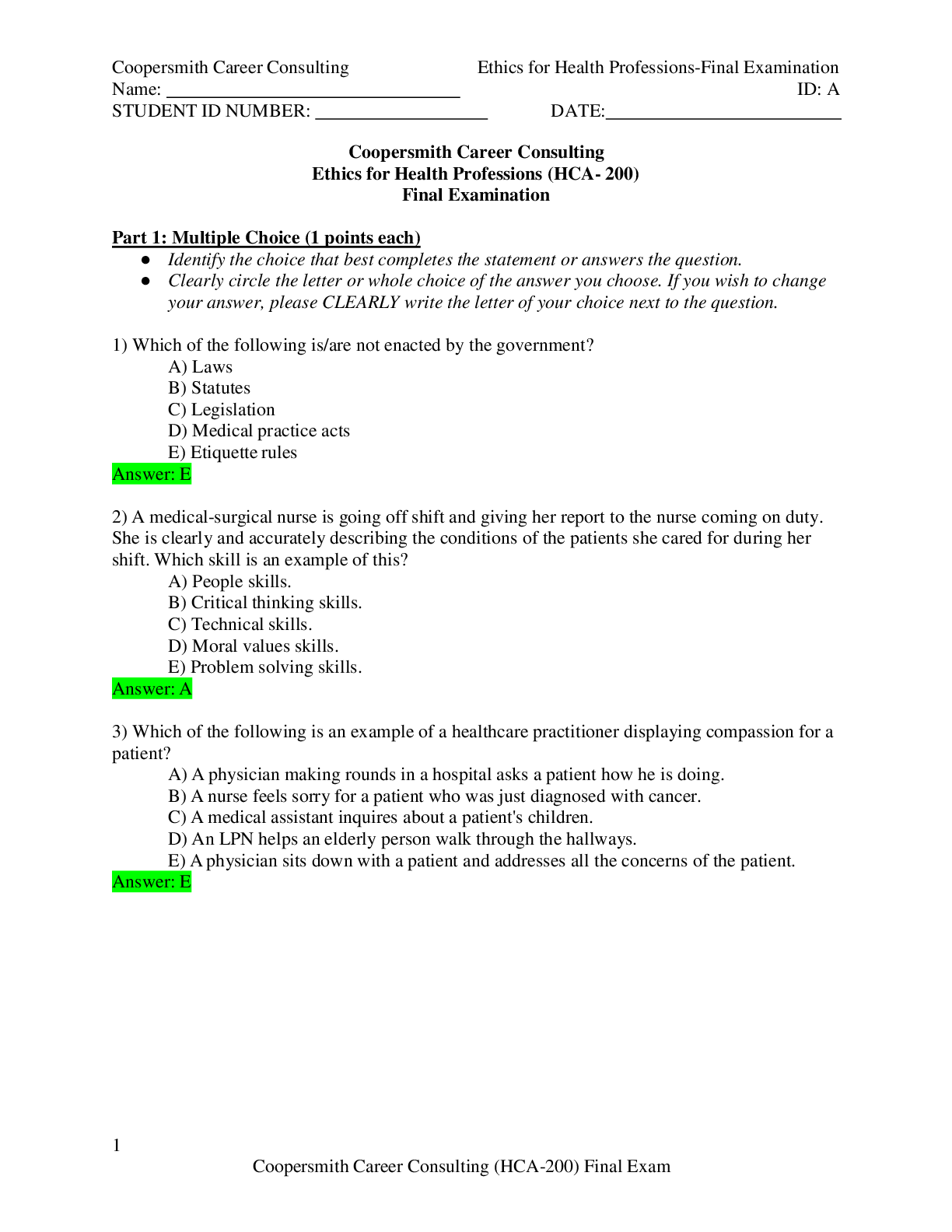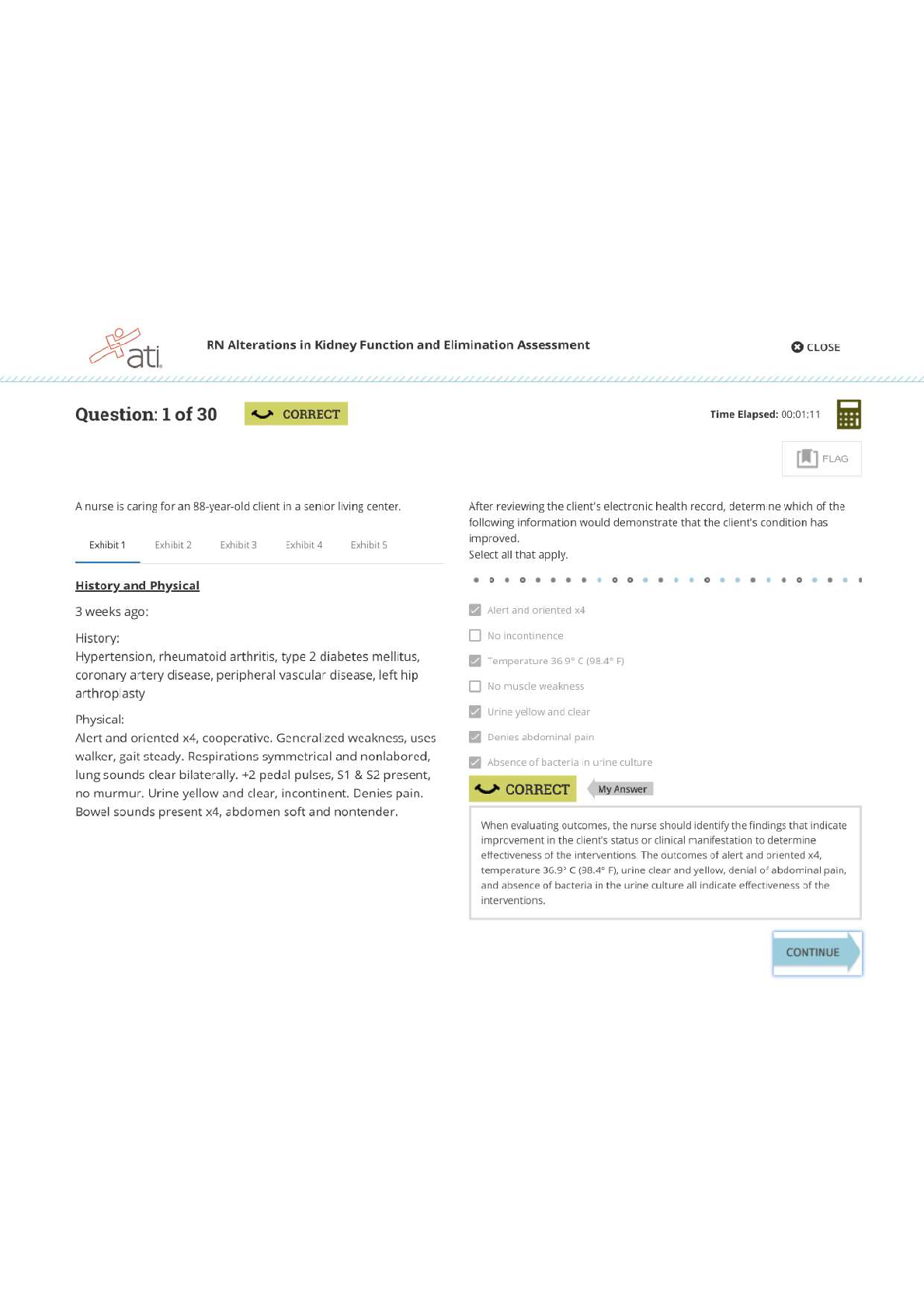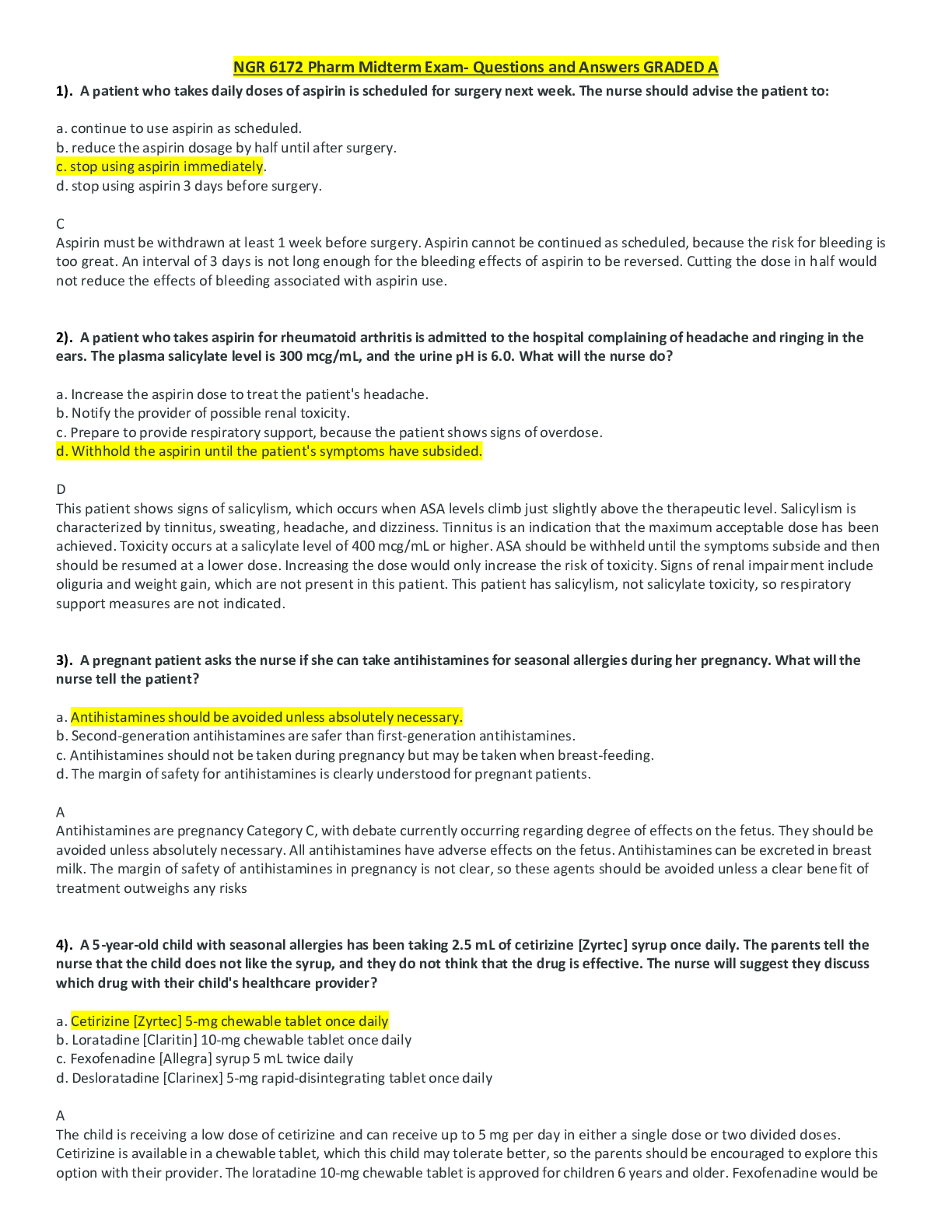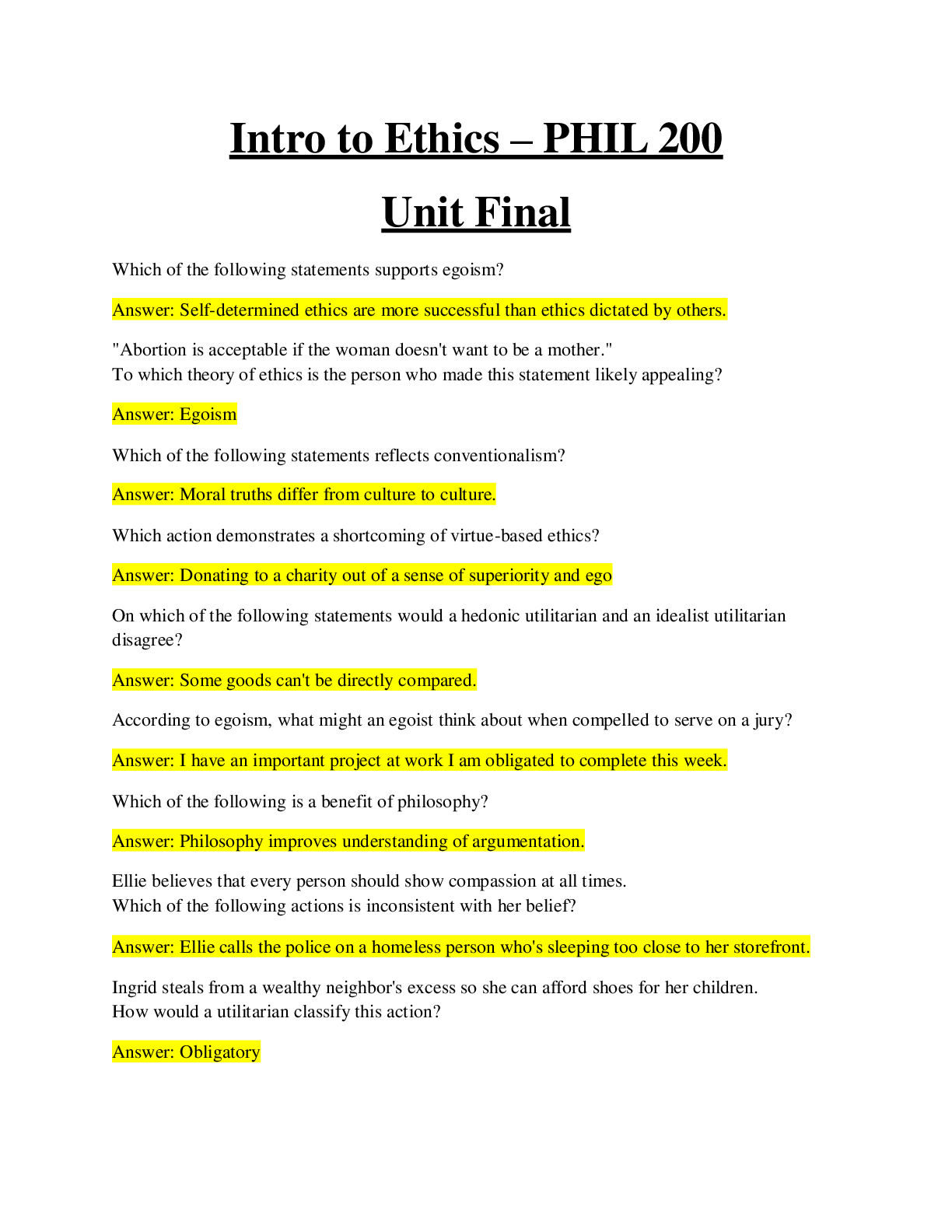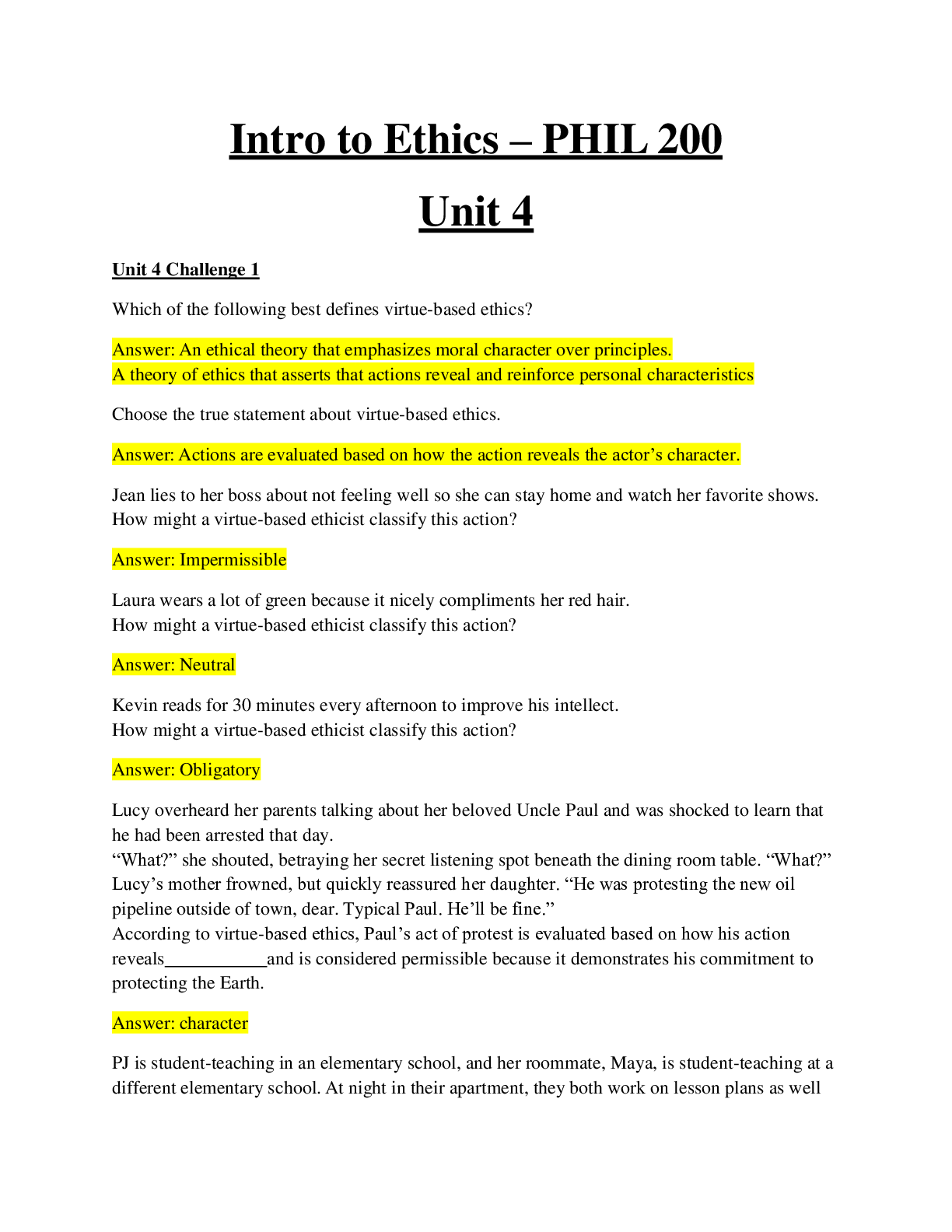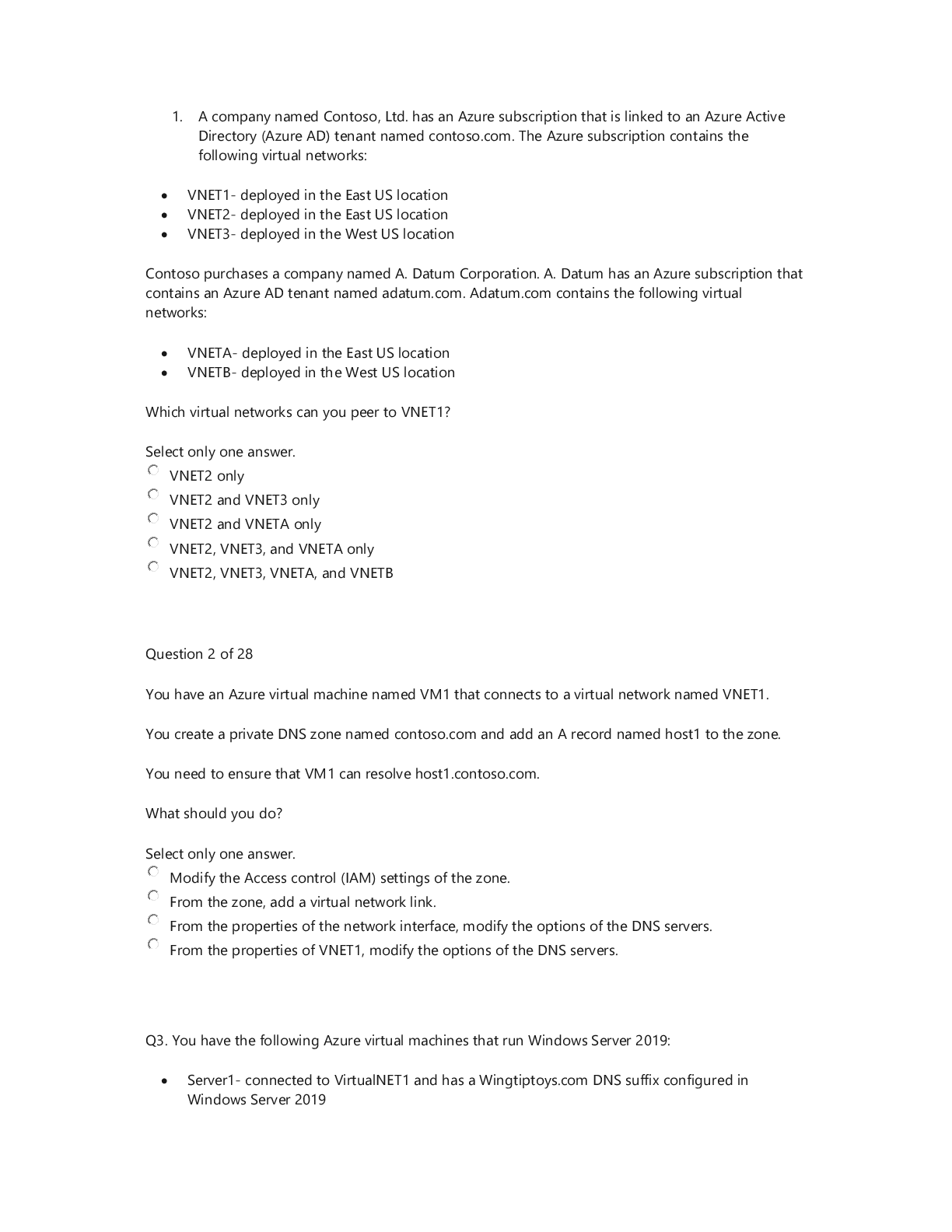HESI Med Surg Exam,Verified answers
Document Content and Description Below
HESI Med Surg Exam An ER nurse is completing an assessment on a patient that is alert but struggles to answer questions. When she attempts to talk, she slurs her speech and appears very frightened. W... hat additional clinical manifestation does the nurse expect to find if nacy's sysmptoms have been caused by a brain attack (stroke)? A. A carotid bruit B. A hypotensive blood pressure C. hyperreflexic deep tendon relexes. D. Decreased bowel sounds Which clinical manifestation further supports an assessment of a left-sided brain attack? A) Visual field deficit on the left side. B) Spatial-perceptual deficits. C) Paresthesia of the left side. D) Global aphasia. When preparing a patient for a noncontrast computed tomography (CT) scan STAT, what nursing intervention should the nurse implement? A) Determine if the client has any allergies to iodine B) Explain that the client will not be able to move her head throughout the CT scan. C) Premedicate the client to decrease pain prior to having the procedure. D) Provide an explanation of relaxation exercises prior to the procedure. A neurologist prescribes a magnetic resonance imaging (MRI) of the head STAT for a patient. Which data warrants immediate intervention by the nurse concerning this diagnostic test? A) Elevated blood pressure. B) Allergy to shell fish. C) Right hip replacement. D) History of atrial fibrillation. A client's daughter is sitting by her mother's bedside who was recently transferred to the Intermediate Care Unit. She states "I don't understand what a brain attack is. The healthcare provider told me my mother is in serious condition and they are going to run several tests. I just don't know what is going on. What happened to my mother?" What is the best response by the nurse? A) "I am sorry, but according to the Health Insurance Portability and Accounting Act (HIPAA), I cannot give you any information." B) "Your mother has had a stroke, and the blood supply to the brain has been blocked." C) "How do you feel about what the healthcare provider said?" D) "I will call the healthcare provider so he/she can talk to you about your mother's serious condition." What is the normal range for cardiac output? A client was admitted with the diagnosis of a brain attack. Their symptoms began 24 hours before being admitted. Why would this client not be a candidate for for thrombolytic therapy? What are plate guards? Which condition is considered a non-modifiable risk factor for a brain attack? A) High cholesterol levels. B) Obesity. C) History of atrial fibrillation. D) Advanced age. A client is experiencing homonymous hemianopsia as the result of a brain attack. Which nursing intervention would the nurse implement to address this condition? A) Turn Nancy every two hours and perform active range of motion exercises. B) Place the objects Nancy needs for activities of daily living on the left side of the table. C) Speak slowly and clearly to assist Nancy in forming sounds to words. D) Request that the dietary department thicken all liquids on Nancy's meal and snack trays. A physical therapist (PT) places a gait belt on a client and is assisting them with ambulation from the bed to the chair. As they get up out of the bed, they report being dizzy and begin to fall. The PT carefully allows them to fall back to the bed and notifies the primary nurse. Which written documentation should the nurse put in the client's record? A) Client experienced orthostatic hypotension when getting out of bed. B) PT reported client complained of dizziness when getting out of bed, and gait belt was used to allow client to fall back onto the bed. C) PT notified the primary nurse that the client could not ambulate at this time because of dizziness. D) Client had difficulty ambulating from the bed to the chair when accompanied by the PT, variance report completed. A new nurse graduate is caring for a postoperative client with the following arterial blood gases (ABGs): pH, 7.30; PCO2, 60 mm Hg; PO2, 80 mm Hg; bicarbonate, 24 mEq/L; and O2 saturation, 96%. Which of these actions by the new graduate is indicated? A) Encourage the client to use the incentive spirometer and to cough. B) Administer oxygen by nasal cannula. C) Request a prescription for sodium bicarbonate from the health care provider. D) Inform the charge nurse that no changes in therapy are needed. The nurse is providing dietary instructions to a 68-year-old client who is at high risk for development of coronary heart disease (CHD). Which information should the nurse include? A) Limit dietary selection of cholesterol to 300 mg per day B) Increase intake of soluble fiber to 10 to 25 grams per day. C) Decrease plant stanols and sterols to less than 2 grams/day. D) Ensure saturated fat is less than 30% of total caloric intake. A splint is prescribed for nighttime use by a client with rheumatoid arthritis. Which statement by the nurse provides the most accurate explanation for use of the splints? A) Prevention of deformities. B) Avoidance of joint trauma. C) Relief of joint inflammation. D) Improvement in joint strength. A 32-year-old female client complains of severe abdominal pain each month before her menstrual period, painful intercourse, and painful defecation. Which additional history should the nurse obtain that is consistent with the client's complaints? A) Frequent urinary tract infections. B) Inability to get pregnant. C) Premenstrual syndrome. D) Chronic use of laxatives. A client with a 16-year history of diabetes mellitus is having renal function tests because of recent fatigue, weakness, elevated blood urea nitrogen, and serum creatinine levels. Which finding should the nurse conclude as an early symptom of renal insufficiency? A) Dyspnea. B) Nocturia. C) Confusion. D) Stomatitis. A client with heart disease is on a continuous telemetry monitor and has developed sinus bradycardia. In determining the possible cause of the bradycardia, the nurse assesses the client's medication record. Which medication is most likely the cause of the bradycardia? A) Propanolol (Inderal). B) Captopril (Capoten). C) Furosemide (Lasix). D) Dobutamine (Dobutrex). A client has been taking oral corticosteroids for the past five days because of seasonal allergies. Which assessment finding is of most concern to the nurse? A) White blood count of 10,000 mm3. B) Serum glucose of 115 mg/dl. C) Purulent sputum. D) Excessive hunger. A female client receiving IV vasopressin (Pitressin) for esophageal varice rupture reports to the nurse that she feels substernal tightness and pressure across her chest. Which PRN protocol should the nurse initiate? A) Start an IV nitroglycerin infusion. B) Nasogastric lavage with cool saline. C) Increase the vasopressin infusion. D) Prepare for endotracheal intubation. A client with gastroesophageal reflux disease (GERD) has been experiencing severe reflux during sleep. Which recommendation by the nurse is most effective to assist the client? A) Losing weight. B) Decreasing caffeine intake. C) Avoiding large meals. D) Raising the head of the bed on blocks. The nurse is caring for a client with syndrome of inappropriate antidiuretic hormone (SIADH), which is manifested by which symptoms? A) Loss of thirst, weight gain. B) Dependent edema, fever. C) Polydipsia, polyuria. D) Hypernatremia, tachypnea. The nurse is planning care for a client with newly diagnosed diabetes mellitus that requires insulin. Which assessment should the nurse identify before beginning the teaching session? A) Present knowledge related to the skill of injection. B) Intelligence and developmental level of the client. C) Willingness of the client to learn the injection sites. D) Financial resources available for the equipment. The nurse is caring for a client who has taken a large quantity of furosemide (Lasix) to promote weight loss. The nurse anticipates the finding of which acid-base imbalance? A) PO2 of 78 mm Hg B) HCO3 of 34 mEq/L C) PCO2 of 56 mm Hg D) pH of 7.31 The nurse is preparing a teaching plan for a client who is newly diagnosed with Type 1 diabetes mellitus. Which signs and symptoms should the nurse describe when teaching the client about hypoglycemia? A) Sweating, trembling, tachycardia. B) Polyuria, polydipsia, polyphagia. C) Nausea, vomiting, anorexia. D) Fruity breath, tachypnea, chest pain. Which reaction should the nurse identify in a client who is responding to stimulation of the sympathetic nervous system? A) Pupil constriction. B) Increased heart rate. C) Bronchial constriction. D) Decreased blood pressure. Which client should the nurse recognize as most likely to experience sleep apnea? A) Middle-aged female who takes a diuretic nightly. B) Obese older male client with a short, thick neck. C) Adolescent female with a history of tonsillectomy. D) School-aged male with a history of hyperactivity disorder. To decrease the risk of acid-base imbalance, what goal must the client with diabetes mellitus strive for? A) Checking blood glucose levels once daily B) Drinking 3 L of fluid per day C) Eating regularly, every 4 to 8 hours D) Maintaining blood glucose level within normal limits After the fourth dose of gentamicin sulfate (Garamycin) IV, the nurse plans to draw blood samples to determine peak and trough levels. When are the best times to draw these samples? A) 15 minutes before and 15 minutes after the next dose. B) One hour before and one hour after the next dose. C) 5 minutes before and 30 minutes after the next dose. D) 30 minutes before and 30 minutes after the next dose. The nurse is caring for a client with an oxygen saturation of 88% and accessory muscle use. The nurse provides oxygen and anticipates which of these physician orders? A) Administration of IV sodium bicarbonate B) Computed tomography (CT) of the chest, stat C) Intubation and mechanical ventilation D) Administration of concentrated potassium chloride solution A male client receives a local anesthetic during surgery. During the post-operative assessment, the nurse notices the client is slurring his speech. Which action should the nurse take? A) Determine the client is anxious and allow him to sleep. B) Evaluate his blood pressure, pulse, and respiratory status. C) Review the client's pre-operative history for alcohol abuse. D) Continue to monitor the client for reactivity to anesthesia. When providing discharge teaching for a client with osteoporosis, the nurse should reinforce which home care activity? A) A diet low in phosphates. B) Skin inspection for bruising. C) Exercise regimen, including swimming. D) Elimination of hazards to home safety. During lung assessment, the nurse places a stethoscope on a client's chest and instructs him/her to say "99" each time the chest is touched with the stethoscope. What should be the correct interpretation if the nurse hears the spoken words "99" very clearly through the stethoscope? A) This is a normal auscultatory finding. B) May indicate pneumothorax. C) May indicate pneumonia. D) May indicate severe emphysema. The nurse is caring for a group of clients with acidosis. The nurse recognizes that Kussmaul respirations are consistent with which situation? A) Client receiving mechanical ventilation B) Use of hydrochlorothiazide C) Aspirin overdose D) Administration of sodium bicarbonate During an interview with a client planning elective surgery, the client asks the nurse, "What is the advantage of having a preferred provider organization insurance plan?" Which response is best for the nurse to provide? A) Long-term relationships with healthcare providers are more likely. B) There are fewer healthcare providers to choose from than in an HMO plan. C) Insurance coverage of employees is less expensive to employers. D) An individual can become a member of a PPO without belonging to a group. A client has taken steroids for 12 years to help manage chronic obstructive pulmonary disease (COPD). When making a home visit, which nursing function is of greatest importance to this client? Assess the client's A) pulse rate, both apically and radially. B) blood pressure, both standing and sitting. C) temperature. D) skin color and turgor. The nurse is teaching a female client who uses a contraceptive diaphragm about reducing the risk for toxic shock syndrome (TSS). Which information should the nurse include? (Select all that apply.) A) Remove the diaphragm immediately after intercourse. B) Wash the diaphragm with an alcohol solution. C) Use the diaphragm to prevent conception during the menstrual cycle. D) Do not leave the diaphragm in place longer than 8 hours after intercourse. E) Contact a healthcare provider a sudden onset of fever grater than 101º F appears. F) Replace the old diaphragm every 3 months. A middle-aged male client with diabetes continues to eat an abundance of foods that are high in sugar and fat. According to the Health Belief Model, which event is most likely to increase the client's willingness to become compliant with the prescribed diet? A) He visits his diabetic brother who just had surgery to amputate an infected foot. B) He is provided with the most current information about the dangers of untreated diabetes. C) He comments on the community service announcements about preventing complications associated with diabetes. D) His wife expresses a sincere willingness to prepare meals that are within his prescribed diet. A female client taking oral contraceptives reports to the nurse that she is experiencing calf pain. What action should the nurse implement? A) Determine if the client has also experienced breast tenderness and weight gain. B) Encourage the client to begin a regular, daily program of walking and exercise. C) Advise the client to notify the healthcare provider for immediate medical attention. D) Tell the client to stop taking the medication for a week to see if symptoms subside. A female client requests information about using the calendar method of contraception. Which assessment is most important for the nurse to obtain? A) Amount of weight gain or weight loss during the previous year. B) An accurate menstrual cycle diary for the past 6 to 12 months. C) Skin pigmentation and hair texture for evidence of hormonal changes. D) Previous birth-control methods and beliefs about the calendar method. The nurse knows that lab values sometimes vary for the older client. Which data should the nurse expect to find when reviewing laboratory values of an 80-year-old male? A) Increased WBC, decreased RBC. B) Increased serum bilirubin, slightly increased liver enzymes. C) Increased protein in the urine, slightly increased serum glucose levels. D) Decreased serum sodium, an increased urine specific gravity. Which postmenopausal client's complaint should the nurse refer to the healthcare provider? A) Breasts feel lumpy when palpated. B) History of white nipple discharge. C) Episodes of vaginal bleeding. D) Excessive diaphoresis occurs at night. The nurse is assisting a client out of bed for the first time after surgery. What action should the nurse do first? A) Place a chair at a right angle to the bedside. B) Encourage deep breathing prior to standing. C) Help the client to sit and dangle legs on the side of the bed. D) Allow the client to sit with the bed in a high Fowler's position. The nurse is receiving report from surgery about a client with a penrose drain who is to be admitted to the postoperative unit. Before choosing a room for this client, which information is most important for the nurse to obtain? A) If suctioning will be needed for drainage of the wound. B) If the family would prefer a private or semi-private room. C) If the client also has a Hemovac® in place. D) If the client's wound is infected. A patient admitted for a head injusry develops dry skin and urine output of 600 mL/hr. Which of the following interventions should the nurse perform first? a) Assess the patient's urine specific gravity b) Slow IV fluid infusion rate c) Assess the patient's level of conciousness d) Notify the physician A patient is prescribed dexamethasone (Decadron) to reduce cerebral edema after a motor vehicle accident. Which of the following assessment findings should the nurse expect if this treatment is effective? a) Increased response to stimuli b) decreased urine output c) respiration rate of 12 d) Increased blood pressure The nurse is assessing a client who is bedfast and refuses to turn or move from a supine position. How should the nurse assess the client for possible dependent edema? A) Compress the flank and upper buttocks. B) Measure the client's abdominal girth. C) Gently palpate the lower abdomen. D) Apply light pressure over the shins. A male client with chronic atrial fibrillation and a slow ventricular response is scheduled for surgical placement of a permanent pacemaker. The client asks the nurse how this devise will help him. How should the nurse explain the action of a synchronous pacemaker? A) Ventricular irritability is prevented by the constant rate setting of pacemaker. B) Ectopic stimulus in the atria is suppressed by the device usurping depolarization. C) An impulse is fired every second to maintain a heart rate of 60 beats per minute. D) An electrical stimulus is discharged when no ventricular response is sensed. The unlicensed assistive personnel (UAP) reports that an 87-year-old female client who is sitting in a chair at the bedside has an oral temperature of 97.2° F. Which intervention should the nurse implement? A) Document the temperature reading on the vital sign graphic sheet. B) Report the temperature to the healthcare provider immediately. C) Instruct the UAP to take the client's temperature again in 30 minutes. D) Advise the UAP to assist the client in returning to her bed. The nurse is completing the health assessment of a 79-year-old male client who denies any significant health problems. Which finding requires the most immediate follow-up assessment? A) Kyphosis with a reduction in height. B) Dilated superficial veins on both legs. C) External hemorrhoids with itching. D) Yellowish discoloration of the sclerae. Which finding should the nurse report to the healthcare provider for a client with a circumferential extremity burn? A) Full thickness burns rather than partial thickness. B) Supinates extremity but unable to fully pronate the extremity. C) Slow capillary refill in the digits with absent distal pulse points. D) Inability to distinguish sharp versus dull sensations in the extremity. The nurse completes visual inspection of a client's abdomen. What technique should the nurse perform next in the abdominal examination? A) Percussion. B) Auscultation. C) Deep palpation. D) Light palpation. A client who has just tested positive for human immunodeficiency virus (HIV) does not appear to hear what the nurse is saying during post-test counseling. Which information should the nurse offer to facilitate the client's adjustment to HIV infection? A) Inform the client how to protect sexual and needle-sharing partners. B) Teach the client about the medications that are available for treatment. C) Identify the need to test others who have had risky contact with the client. D) Discuss retesting to verify the results, which will ensure continuing contact. The nurse hears short, high-pitched sounds just before the end of inspiration in the right and left lower lobes when auscultating a client's lungs. How should this finding be recorded? A) Inspiratory wheezes in both lungs. B) Crackles in the right and left lower lobes. C) Abnormal lung sounds in the bases of both lungs. D) Pleural friction rub in the right and left lower lobes. A client asks the nurse about the purpose of beginning chemotherapy (CT) because the tumor is still very small. Which information supports the explanation that the nurse should provide? A) Side effects are less likely if therapy is started early. B) Collateral circulation increases as the tumor grows. C) Sensitivity of cancer cells to CT is based on cell cycle rate. D) The cell count of the tumor reduces by half with each dose. The nurse is caring for a client with non-Hodgkin's lymphoma who is receiving chemotherapy. Laboratory results reveal a platelet count of 10,000/ml. What action should the nurse implement? A) Encourage fluids to 3000 ml/day. B) Check stools for occult blood. C) Provide oral hygiene every 2 hours. D) Check for fever every 4 hours. The nurse is caring for a client with end stage liver disease who is being assessed for the presence of asterixis. To assess the client for asterixis, what position should the nurse ask the client to demonstrate? A) Extend the left arm laterally with the left palm upward. B) Extend the arm, dorsiflex the wrist, and extend the fingers. C) Extend the arms and hold this position for 30 seconds. D) Extend arms with both legs adducted to shoulder width. During the assessment of a client who is 24 hours post-hemicolectomy with a temporary colostomy, the nurse determines that the client's stoma is dry and dark red in color. What action should the nurse implement? A) Notify the surgeon. B) Document the assessment. C) Secure a colostomy pouch over the stoma. D) Place petrolatum gauze dressing over the stoma. What assessment finding should the nurse identify that indicates a client with an acute asthma exacerbation is beginning to improve after treatment? A) Wheezing becomes louder. B) Cough remains unproductive. C) Vesicular breath sounds decrease. D) Bronchodilators stimulate coughing. A client is admitted to the emergency department after being lost for four days while hiking in a national forest. Upon review of the laboratory results, the nurse determines the client's serum level for thyroid-stimulating hormone (TSH) is elevated. Which additional assessment should the nurse make? A) Body mass index. B) Skin elasticity and turgor. C) Thought processes and speech. D) Exposure to cold environmental temperatures. Which method elicits the most accurate information during a physical assessment of an older client? A) Ask the client to recount one's health history. B) Obtain the client's information from a caregiver. C) Review the past medical record for medications. D) Use reliable assessment tools for older adults. The nurse obtains a client's history that includes right mastectomy and radiation therapy for cancer of the breast 10 years ago. Which current health problem should the nurse consider is a consequence of the radiation therapy? A) Asthma. B) Myocardial infarction. C) Chronic esophagitis with gastroesophageal reflux. D) Pathologic fracture of two ribs on the right chest. Three weeks after discharge for an acute myocardial infarction (MI), a client returns to the cardiac center for follow-up. When the nurse asks about sleep patterns, the client tells the nurse that he sleeps fine but that his wife moved into the spare bedroom to sleep when he returned home. He states, I guess we will never have sex again after this. Which response is best for the nurse to provide? A) Sexual intercourse can be strenuous on your heart, but closeness and intimacy, such as holding and cuddling, can be maintained with your wife. B) Sexual activity can be resumed whenever you and your wife feel like it because the sexual response is more emotional rather than physical. C) You should discuss your questions about your sexual activity with your healthcare provider because sexual activity may be limited by your heart damage. D) Sexual activity is similar in cardiac workload and energy expenditure as climbing two flights of stairs and may be resumed like other activities. An 85-year-old male client comes to the clinic for his annual physical exam and renewal of antihypertensive medication prescriptions. The client's radial pulse rate is 104 beats/minute. Which additional assessment should the nurse complete? A) Palpate the pedal pulse volume. B) Count the brachial pulse rate. C) Measure the blood pressure. D) Assess for a carotid bruit. The nurse is preparing a teaching plan for a client with newly diagnosed glacoma and a history of allergic rhinitis. Which information is most important for the nurse to provide the client about using over-the-counter (OTC) medications for allergies? A) Notify your healthcare provider if there is an increase in heart rate. B) Increase fluid intake while taking an antihistamine or decongestant. C) Avoid allergy medications that contain pseudoephedrine or phenylephrine. D) Ophthalmic lubricating drops may be used for eye dryness due to allergy medications. The nurse should explain to a client with lung cancer that pleurodesis is performed to achieve which expected outcome? A) Prevent the formation of effusion fluid. B) Remove fluid from the intrapleural space. C) Debulk tumor to maintain patency of air passages. D) Relieve empyema after pneumonectomy. A female client with type 2 diabetes mellitus reports dysuria. Which assessment finding is most important for the nurse to report to the healthcare provider? A) Suprapubic pain and distention. B) Bounding pulse at 100 beats/minute. C) Fingerstick glucose of 300 mg/dl. D) Small vesicular perineal lesions. A nurse is preparing a teaching plan for a client who is post-menopausal. Which measure is most important for the nurse to include to prevent osteoporosis? A) Take a multivitamin daily. B) Use only low fat milk products. C) Perform weight resistance exercises. D) Bicycle for at least 3 miles every day. A young adult female reports that she is experiencing a lack of appetite, hypersomnia, stress incontinence, and heart palpitations. Which symptom is characteristic of premenstrual syndrome? A) Heart palpitations. B) Anorexia. C) Hypersomnia. D) Stress incontinence. A nurse is preparing to insert an IV catheter after applying an eutectic mixture of lidocaine and prilocaine (EMLA), a topical anesthetic cream. What action should the nurse take to maximize its therapeutic effect? A) Rub a liberal amount of cream into the skin thoroughly. B) Cover the skin with a gauze dressing after applying the cream. C) Leave the cream on the skin for 1 to 2 hours before the procedure. D) Use the smallest amount of cream necessary to numb the skin surface. A 26-year-old male client with Hodgkin's disease is scheduled to undergo radiation therapy. The client expresses concern about the effect of radiation on his ability to have children. What information should the nurse provide? A) The radiation therapy causes the inability to have an erection. B) Radiation therapy with chemotherapy causes temporary infertility. C) Permanent sterility occurs in male clients who receive radiation. D) The client should restrict sexual activity during radiotherapy. The nurse is preparing discharge instructions for a client who is going home with a surgical wound on the coccyx that is healing by second intention. What is the priority nursing diagnosis that should guide the discharge instruction plan? A) Acute pain. B) Risk for infection. C) Disturbed body image. D) Risk for deficient fluid volume. The nurse is preparing an adult client for an upper gastrointestinal (UGI) series. Which information should the nurse include in the teaching plan? A) The xray procedure may last for several hours. B) A nasogastric tube (NGT) is inserted to instill the barium. C) Enemas are given to empty the bowel after the procedure. D) Nothing by mouth is allowed for 6 to 8 hours before the study. A client is admitted to the hospital with a traumatic brain injury after his head violently struck a brick wall during a gang fight. Which finding is most important for the nurse to assess further? A) A scalp laceration oozing blood. B) Serosanguineous nasal drainage. C) Headache rated 10 on a 0-10 scale. D) Dizziness, nausea and transient confusion. When planning care for a client with right renal calculi, which nursing diagnosis has the highest priority? A) Acute pain related to movement of the stone. B) Impaired urinary elimination related to obstructed flow of urine. C) Risk for infection related to urinary stasis. D) Deficient knowledge related to need for prevention of recurrence of calculi. What instruction should the nurse include in the discharge teaching for a client who needs to perform self-catheterization technique at home? A) Catheterize every 3 to 4 hours. B) Maintain sterile technique. C) Use the Credé maneuver before catheterization. D) Drink 500 ml of fluid within 2 hours of catheterization. The nurse is preparing a client for orthopedic surgery on the left leg and completing a safety checklist before transport to the operating room. Which items should the nurse remove from the client? (Select all that apply.) A) Nail polish. B) Hearing aid. C) Wedding band. D) Left leg brace. E) Contact lenses. F) Partial dentures. A client's prostate-specific antigen (PSA) exam result showed a PSA density of 0.13 ng/ml. Which conclusion regarding this lab data is accurate? A) Probable prostatitis. B) Low risk for prostate cancer. C) The presence of cancer cells. D) Biopsy of the prostate is indicated. The nurse is providing postoperative instructions for a female client after a mastectomy. Which information should the nurse include in the teaching plan? (Select all that apply.) A) Empty surgical drains once a week using procedure gloves. B) Report inflammation of the incision site or the affected arm. C) Wear clothing with snug sleeves over the arm on the operative side. D) Avoid lifting more than 4.5 kg (10 lb) or reaching above her head. , or tight jewelry, should be avoided. Which sexually transmitted infection (STI) should the nurse include in a client's teaching plan about the risk for cervical cancer? A) Neisseria gonorrhoea. B) Chlamydia trachomatis. C) Herpes simplex virus. D) Human papillomavirus. A client who returns to the unit after having a percutaneous transluminal coronary angioplasty (PTCA) complains of acute chest pain. What action should the nurse implement next? A) Inform the healthcare provider. B) Obtain a 12-lead electrocardiogram. C) Give a sublingual nitroglycerin tablet. D) Administer prescribed analgesic. A client is admitted to the Emergency Department with a tension pneumothorax. Which assessment should the nurse expect to identify? A) An absence of lung sounds on the affected side. B) An inability to auscultate tracheal breath sounds. C) A deviation of the trachea toward the side opposite the pneumothorax. D) A shift of the point of maximal impulse to the left, with bounding pulses. A middle-aged male client asks the nurse what findings from his digital rectal examination (DRE) prompted the healthcare provider to prescribe a repeat serum prostatic surface antigen (PSA) level. What information should the nurse provide? A) A uniformly enlarged prostate is benign prostatic hypertrophy that occurs with aging. B) The spongy or elastic texture of the prostate is normal and requires no further testing. C) An infection is usually present when the prostate indents when a finger is pressed on it. D) Stony, irregular nodules palpated on the prostate should be further evaluated. What is the primary nursing diagnosis for a client with asymptomatic primary syphilis? A) Acute pain. B) Risk for injury. C) Sexual dysfunction. D) Deficient knowledge. The nurse is caring for a client with human immunodeficiency virus (HIV) infection who develops Mycobacterium avium complex (MAC). What is the most significant desired outcome for this client? A) Free from injury of drug side effects. B) Return to pre-illness weight. C) Adequate oxygenation. D) Maintenance of intact perineal skin. The nurse is caring for a client receiving tamoxifen (Nolvadex) for the treatment of breast cancer. Which action should the nurse include in the client's plan of care? A) Increase fluid intake. B) Monitor sodium chloride intake. C) Assist the client in coping with hot flashes. D) Encourage milk products to increase calcium intake. A client in the preoperative holding area receives a prescription for midazolam (Versed) IV. The nurse determines that the surgical consent form needs to be signed by the client. Which action should the nurse implement? A) Give the drug and allow the client to read and sign the consent form. B) Counter-sign the client's initials on the consent form after giving the drug. C) Withhold the drug until the client validates understanding of the surgical procedure and signs the consent form. D) Call the healthcare provider to explain the surgical procedure before the client signs the consent. A client who is receiving the sixth unit of packed red blood cell transfusion is demonstrating signs and symptoms of a febrile, nonhemolytic reaction. What assessment finding is most important for the nurse to identify? A) Increased anxiety since the transfusion began. B) Drowsiness after receiving diphenhydramine (Benadryl). C) Complaints of feeling cold. D) Flushed skin and headache. A 48-year-old client with endometrial cancer is being discharged after a total hysterectomy and bilateral salpingo-oophorectomy. Which client statement indicates that further teaching is needed? A) Well, I don't have to worry about getting pregnant anymore. B) I can't wait to go on the cruise that I have planned for this summer. C) I know I will miss having sexual intercourse with my husband. D) I have asked my daughter to stay with me next week after I am discharged. A client with a fractured right radius reports severe, diffuse pain that has not responded to the prescribed analgesics. The pain is greater with passive movement of the limb than with active movement by the client. The nurse recognizes that the client is most likely exhibiting symptoms of which condition? A) Acute compartment syndrome. B) Fat embolism syndrome. C) Venous thromboembolism. D) Aseptic ischemic necrosis. A client who had abdominal surgery two days ago has prescriptions for intravenous morphine sulfate 4 mg every 2 hours and a clear liquid diet. The client complains of feeling distended and has sharp, cramping gas pains. What nursing intervention should be implemented? A) Obtain a prescription for a laxative. B) Withhold all oral fluid and food. C) Assist the client to ambulate in the hall. D) Administer the prescribed morphine sulfate. The nurse is caring for a male client who had an inguinal herniorrhaphy 3 hours ago. The nurse determines the client's lower abdomen is distended and assesses dullness to percussion. What is the priority nursing action? A) Assessment of the client's vital signs. B) Document the finding as the only action. C) Determine the time the client last voided. D) Insert a rectal tube for the passage of flatus. A client who is receiving a whole blood transfusion develops chills, fever, and a headache 30 minutes after the transfusion is started. The nurse should recognize these symptoms as characteristic of what reaction? A) A mild allergic reaction. B) A febrile transfusion reaction. C) An anaphylactic transfusion reaction. D) An acute hemolytic transfusion reaction. A client with a recent history of blood in his stools is scheduled for a proctosigmoidoscopy. The nurse should implement which protocols to prepare the client for this procedure? (Select all that apply.) A) Obtain consent for the procedure. B) Initiate preoperative sedation. C) Begin fast the morning of the procedure. D) Administer an enema before the procedure. E) Provide a clear-liquid diet 48 hours before the procedure. A client with osteoarthritis requests information from the nurse about what type of exercise regimen would be most beneficial for him. The nurse should communicate which information? A) Low impact exercise, walking, swimming and water aerobics. B) Repetitive strength-building exercises with weights or resistance bands. C) Circuit training alternating with frequent rest periods. D) High-impact aerobic exercise. The nurse is caring for a client with syndrome of inappropriate antidiuretic hormone (SIADH). This condition is most often related to which predisposing condition? A) Small cell lung cancer. B) Active tuberculosis infection. C) Hodgkin's lymphoma. D) Tricyclic antidepressant therapy. A man who smokes two packs of cigarettes a day wants to know if smoking is contributing to the difficulty that he and his wife are having getting pregnant. What information is best for the nurse to provide? (Select all that apply.) A) Only marijuana cigarettes affect sperm count. B) Smoking can decrease the quantity and quality of sperm. C) The first semen analysis should be repeated to confirm sperm counts. D) Cessation of smoking improves general health and fertility. E) Sperm specimens should be collected in 2 subsequent days. Which finding should the nurse identify as an indication of carbon monoxide poisoning in a client who experienced a burn injury during a house fire? A) Pulse oximetry reading of 80%. B) Expiratory stridor and nasal flaring. C) Cherry red color to the mucous membranes. D) Presence of carbonaceous particles in sputum. The nurse is giving discharge instructions to a client with chronic prostatitis. What instruction should the nurse provide the client to reduce the risk of spreading the infection to other areas of the client's urinary tract? A) Wear a condom when having sexual intercourse. B) Avoid consuming alcohol and caffeinated beverages. C) Empty the bladder completely with each voiding. D) Have intercourse or masturbate at least twice a week. The nurse is providing discharge instructions to a client who has undergone a left orchiectomy for testicular cancer. Which statement indicates that the client understands his post-operative care and prognosis? A) I should continue to perform testicular self-examination (TSE) monthly on my remaining testicle. B) I should wear an athletic supporter and cup to prevent testicular cancer in my remaining testicle. C) I should always use a condom because I am at increased risk for acquiring a sexually transmitted disease. D) I should make sure my sons know how to perform TSE because they are at increased risk for this type of cancer. The nurse is assessing a client with a chest tube that is attached to suction and a closed drainage system. Which finding is most important for the nurse to further assess? A) Upper chest subcutaneous emphysema. B) Tidaling (fluctuation) of fluid in the water-seal chamber. C) Constant air bubbling in the suction-control chamber. D) Pain rated 8 (0-10) at the insertion site. A couple trying to cope with an infertility problem wants to know what can be done to preserve emotional equilibrium. What is the best response for the nurse to provide? A) Tell your friends and family so that they can help you. B) Get involved with a support group. I will give you some names. C) Talk only to other friends who are infertile since only they can help. D) Start adoption proceedings immediately since obtaining an infant is very difficult. The nurse is planning preoperative teaching for a client who will undergo a radical neck dissection and total laryngectomy. Which information has the greatest priority for this client? A) Prognosis after treatment is excellent. B) Techniques for esophageal speech are relatively easy to learn with practice. C) The stoma should never be covered after this type of surgery. D) There is a radical change in appearance as a result of this surgery. When teaching a client with breast cancer about the prescribed radiation therapy for treatment, what information is important to include? A) Dry, itchy skin changes may occur. B) There is a possibility of long bone pain. C) Permanent pigment changes to the breast may result. D) A low-residue diet may be ordered to reduce the likelihood of diarrhea. Which action should the nurse implement on the scheduled day of surgery for a client with type 1 diabetes mellitus (DM)? A) Obtain a prescription for an adjusted dose of insulin. B) Administer an oral anti-diabetic agent. C) Give an insulin dose using parameters of a sliding scale. D) Withhold insulin while the client is NPO. In planning care for a client with an acute stroke resulting in right-sided hemiplegia, which positioning should the nurse should use to maintain optimal functioning? A) Mid-Fowler's with knees supported. B) Supine with trochanter rolls to the hips. C) Sim's position alternated with right lateral position q2 hours. D) Left lateral, supine, brief periods on the right side, and prone. Which intervention should the nurse implement that best confirms placement of an endotracheal tube (ET) tube? A) Use an end-tital CO2 detector. B) Ascultate for bilateral breath sounds. C) Obtain pulse oximeter reading. D) Check symmetrical chest movement. A female client with hyperesthesia on the oncology unit is using a transcutaneous electrical nerve stimulation (TENS) unit for chronic pain. Which nursing activity should the nurse implement instead of delegating to a practical nurse (PN)? A) Determine the client's level of discomfort using a pain rating scale. B) Ask the client about her past experience with chronic pain. C) Observe the client's facial expressions for pain and discomfort. D) Evaluate the client's ability to adjust the voltage to control pain. The nurse is caring for a client scheduled to undergo insertion of a percutaneous endoscopic gastrostomy (PEG) tube. The client asks the nurse to explain how a PEG tube differs from a gastrostomy tube (GT). Which explanation best describes how they are different? A) Method of insertion. B) Location of the tubes. C) Diameter of the tubes. D) Procedure for feedings. The nurse is caring for a client after a transurethral resection of the prostate and determines the client's urinary catheter is not draining. What should the nurse implement? A) Reposition the catheter drainage tubing. B) Encourage the client to drink oral fluids. C) Irrigate the catheter. D) Change drainage unit tubing. A client is admitted after blunt abdominal injury. Which assessment finding requires immediate action by the nurse? A) Radiating abdominal pain with left lower quadrant palpation. B) Grimacing after palpation of the right hypochondriac region. C) Rebound tenderness with abdominal palpation. D) Bluish periumbilical skin discoloration. The PET (positron emission tomography) scan is commonly used with oncology clients to provide for which diagnostic information? A) A description of inflammation, infection, and tumors. B) Continuous visualization of intracranial neoplasms. C) Imaging of tumors without exposure to radiation. D) An image that describes metastatic sites of cancer. A client with rheumatoid arthritis is prescribed piroxicam (Feldene), a nonsteroidal anti-inflammatory drug (NSAID). Which effect is characteristic of (NSAIDs) used for treating rheumatoid arthritis? A) Production of replacement cartilage is stimulated. B) Further destruction of the articular cartilage is prevented. C) Inflammation is reduced by inhibiting prostaglandin synthesis. D) Bradykinin is inhibited, thereby reducing acute and chronic pain. A deficiency of intrinsic factor should alert the nurse to assess a client's history for which condition? A) Emphysema. B) Hemophilia. C) Pernicious anemia. D) Oxalic acid toxicity. A client with a history of hypertension, myocardial infarction, and heart failure is admitted to the surgical intensive care unit after coronary artery bypass surgery graft (CABG). The nurse determines the client's serum potassium level is 4.5 mEq/L. What action should the nurse implement? A) Notify the healthcare provider. B) Decrease the IV solution flow rate. C) Document the finding as the only action. D) Administer potassium replacement as prescribed. A client with type II diabetes arrives at the clinic with a blood glucose of 50 mg/dL. The nurse provides the client with 6 ounces of orange juice. In 15 minutes the client's capillary glucose is 74 mg/dL. What action should the nurse take? A) Obtain a specimen for serum glucose level. B) Administer insulin per sliding scale. C) Provide cheese and bread to eat. D) Collect a glycosylated hemoglobin specimen. A client who is admitted to the coronary care unit with a myocardial infarction (MI) begins to develop increased pulmonary congestion, an increase in heart rate from 80 to 102 beats per minute, and cold, clammy skin. What action should the nurse implement? A) Notify the healthcare provider. B) Increase the IV flow rate. C) Place the client in the supine position. D) Prepare the client for an emergency echocardiography. Which signs and symptoms are associated with arterial insufficiency? A) Pallor, intermittent claudication. B) Pedal edema, brown pigmentation. C) Blanched skin, lower extremity ulcers. D) Peripheral neuropathy, cold extremities. The nurse is assessing a middle-aged male client for risk factors related to chronic illness. Which finding should the nurse assess further? A) Thinning hair and dry scalp. B) Increase in appetite and taste-bud acuity. C) Increase in muscle tone but decreased muscle strength. D) Increase in abdominal fat deposits. The nurse directs an unlicensed assistive personnel (IAP) to obtain the vital signs for a client who returns to the unit after having a mastectomy for cancer. What information should the nurse provide the UAP? A) Elevate the arm with an IV infusing on the operative side with a pillow. B) Apply the blood pressure cuff to the arm on the unoperative side. C) Position the arm on the operative side close to the body. D) Collect a fingerstick blood specimen from the arm on the operative side. The severity of diabetic retinopathy is directly related to which condition? A) Poor blood glucose control. B) Neurological effects of diabetes. C) Susceptibility to infection. D) Uncontrolled hypertension. A client with acute appendicitis is experiencing anxiety and loss of sleep about missing final examination week at college. Which outcome is most important for the nurse to include in the plan of care? A) Sleeping six to eight hours. B) Achieve a sense of control. C) Utilize problem solving skills. D) Increased focus of attention. Which client should the nurse assess first? A) A 27-year-old complaining of severe back pain. B) A 63-year-old complaining of foot and ankle pain. C) A 49-year-old with pancreatitis complaining of unrelenting abdominal pain. D) A 55-year-old newly admitted client complaining of jaw pain and indigestion. The nurse is caring for a client who is admitted with a hemorrhagic stroke. Which nursing action should be included in the plan of care? A) Perform active range of motion three times daily. B) Monitor for Battle's sign every four hours. C) Teach measures to avoid the Valsalva maneuver. D) Maintain the head of bed in a flat position. The nurse is assessing a client admitted from the emergency room with gastrointestinal bleeding related to peptic ulcer disease (PUD). Which physiological factors can produce ulceration? (Select all that apply.) A) Vagal stimulation. B) An increased level of stress. C) Decreased duodenal inhibition. D) Hypersecretion of hydrochloric acid. E) An increased number of parietal cells. Which condition is associated with an oversecretion of renin? A) Hypertension. B) Diabetes mellitus. C) Diabetes insipidus. D) Alzheimer's disease. The nurse is caring for a client who had an excision of a malignant pituitary tumor. Which findings should the nurse document that indicate the client is developing syndrome of inappropriate antidiuretic hormone (SIADH)? A) Hypernatremia and periorbial edema. B) Muscle spasticity and hypertension. C) Weight gain with low serum sodium. D) Increased urinary output and thirst. The nurse is assessing a postmenopausal woman who is complaining of urinary urgency and frequency and stress incontinence. She also reports difficulty in emptying her bladder. These complaints are most likely due to which condition? A) Cystocele. B) Bladder infection. C) Pyelonephritis. D) Irritable bladder. The nurse is caring for a client who returns to the unit following a colonoscopy. Which finding should the nurse report to the healthcare provider immediately? A) Large amounts of expelled flatus with mucus. B) Tympanic abdomen and hyperactive bowel sounds. C) Increased abdominal pain with rebound tenderness. D) Complaint of feeling weak with watery diarrheal stools. A Korean-American client, who speaks very little English, is being discharged following surgery. Which nurse should the nurse manager assign to provide the discharge instructions for the client? A) A graduate registered nurse (RN) with three weeks of experience. B) The registered nurse (RN) case manager for the unit with 1 year's experience. C) A floating registered nurse (RN) with five years of nursing experience. D) A Korean-American practical nurse (PN) with six years of nursing experience. A client's susceptibility to ulcerative colitis is most likely due to which aspect in the client's history? A) Jewish European ancestry. B) H. pylori bowel infection. C) Family history of irritable bowel syndrome. D) Age between 25 and 55 years. A college student who is diagnosed with a vaginal infection and vulva irritation describes the vaginal discharge as having a cottage-cheese appearance. Which prescription should the nurse implement first? A) Cleanse perineum with warm soapy water 3 times per day. B) Instill the first dose of nystatin (Mycostatin) vaginally per applicator. C) Perform glucose measurement using a capillary blood sample. D) Obtain a blood specimen for sexually transmitted diseases (STDs). A male client with sickle cell anemia, who has been hospitalized for another health problem, tells the nurse he has had an erection for over 4 hours. What action should the nurse implement first? A) Notify the client's healthcare provider. B) Document the finding in the client record. C) Prepare a warm enema solution for rectal instillation. D) Obtain a large bore needle for aspiration of the corpora cavernosa. The healthcare provider prescribes high-protein, high-fat, low-carbohydrate diet with limited fluids during meals for a client recovering from gastric surgery. The client asks the nurse what the purpose is for this type of diet. Which rationale should be included in the nurse's explanation to this client? A) It is quickly digested. B) It does not cause diarrhea. C) It does not dilate the stomach. D) It is slow to leave the stomach. The nurse is assessing a client with a cuffed tracheostomy tube in place who is breathing spontaneously. To evaluate if the client can tolerate cuff deflation to promote speaking and swallowing, what action should the nurse implement? A) Ask the client to try to speak. B) Assess for respiratory distress. C) Auscultate for pulmonary crackles after the client drinks a small amount of clear water. D) Observe the client for coughing colored sputum after drinking a small amount of colored water. A client's family asks why their mother with heart failure needs a pulmonary artery (PA) catheter now that she is in the intensive care unit (ICU). What information should the nurse include in the explanation to the family? A) A central monitoring system reduces the risk of complications undetected by observation. B) A pulmonary artery catheter measures central pressures for monitoring fluid replacement. C) Pulmonary artery catheters allow for early detection of lung problems. D) The healthcare provider should explain the many reasons for its use. An older female client is admitted with atrophic vaginitis and perineal cutaneous candidiasis. What is the priority nursing diagnosis for this client? A) Risk for injury. B) Impaired comfort. C) Disturbed body image. D) Ineffective health maintenance. A male client with a prostatic stent is preparing for discharge. What should the nurse ensure the client understands? A) Ongoing antibiotic therapy is needed for one year. B) The client should not undergo magnetic resonance imaging. C) Increased frequency of assessment for prostatic cancer is needed. D) The client should not be catheterized through the stent for at least three months. Which client is at highest risk for compromised psychological adjustment after a hysterectomy? A) A 46-year-old woman with three children and a recent promotion at work. B) A 55-year-old woman with abnormal bleeding and pain for 3 years. C) A 62-year-old widow who has three friends who had uncomplicated hysterectomies. D) A 29-year-old woman whose uterus ruptured after giving birth to her first child. A client with sickle cell anemia is admitted with severe abdominal pain and the diagnosis is sickle cell crisis. What is the most important nursing action to implement? A) Limit the client's intake of oral fluids and food. B) Evaluate the effectiveness of narcotic analgesics. C) Encourage the client to ambulate as tolerated. D) Teach the client about prevention of crises. When observing a client for symptoms of a large bowel obstruction, the nurse should assess for which finding? A) Distention of the lower abdomen. B) Nausea with profuse vomiting. C) Upper abdominal discomfort. D) Fluid and electrolyte imbalances. . A client with a chronic infection of Hepatitis C virus (HCV) is scheduled for a liver biopsy. Which intervention should the nurse perform after the procedure? A) Progress activity as soon as possible. B) Assess for signs of bleeding and hypovolemia. C) Place the client in the left lateral position. D) Monitor blood pressure, pulse and breathing every 4 hours. The home health nurse is assessing a client with terminal lung cancer who is receiving hospice care. Which activity should be assigned to the hospice practical nurse (PN)? A) Administer medications for pain relief, shortness of breath, and nausea. B) Clarify family members' feelings about the meaning of client behaviors and symptoms. C) Develop a plan of care after assessing the needs of the client and family. D) Teach the family to recognize restlessness and grimacing as signs of client discomfort. A 24-year-old female client diagnosed with a human papillomavirus infection (HPV) is angry at her ex-boyfriend and says she is not going to tell him that he is infected. What response is best for the nurse to provide? A) You do not have to tell him because this is not a reportable disease. B) Because there is no cure for this disease, telling him is of no benefit to him or to you. C) Even though you are angry, he should be told, so he can take precautions to prevent the spread of infection. D) You should tell him, so he can feel as guilty and miserable as you do now, knowing that you have this disease. The nurse is caring for a client who is two days postoperative. Which observation should alert the nurse to call the Rapid Response Team (RRT)? A) Fresh bleeding noted on abdominal surgical wound dressing. B) Pulse change from 85 to160 beats/minute lasting more than 10 minutes. C) Temperature of 103.1° F and white blood cell (WBC) count of 16,000 mm3. D) Weakness, diaphoresis, complaints of feeling faint. BP 100/56 mm Hg. A client with Ménière's disease is incapacitated by vertigo and is lying in bed grasping the side rails and staring at the television. Which nursing intervention should the nurse implement? A) Encourage fluids to 3000 ml per day. B) Change the client's position every two hours. C) Keep the head of the bed elevated 30 degrees. D) Turn off the television and darken the room. Which preexisting diagnosis places a client at greatest risk of developing superior vena cava syndrome? A) Carotid stenosis. B) Steatosis hepatitis. C) Metastatic cancer. D) Clavicular fracture. A client with osteoarthritis receives a prescription for Naproxen (Naprosyn). Which potential side effect should the nurse provide to the client about this medication? A) Sensitivity to sunlight. B) Muscle fasciculations. C) Increased urinary frequency. D) Gastrointestinal disturbance. What information should the nurse include in a teaching plan about the onset of menopause? (Select all that apply). A) Smoking. B) Oophorectomy with hysterectomy. C) Early menarche. D) Cardiac disease. E) Genetic influence. F) Chemotherapy exposure. The nurse is caring for a client with a small bowel obstruction. The client is vomiting foul smelling fecal-like material. What action should the nurse implement? A) Administer antiemetics every 2 to 3 hours. B) Position on the left side with knees drawn up. C) Encourage ice chips sparingly. D) Give IV fluids with electrolytes. [Show More]
Last updated: 1 month ago
Preview 1 out of 28 pages
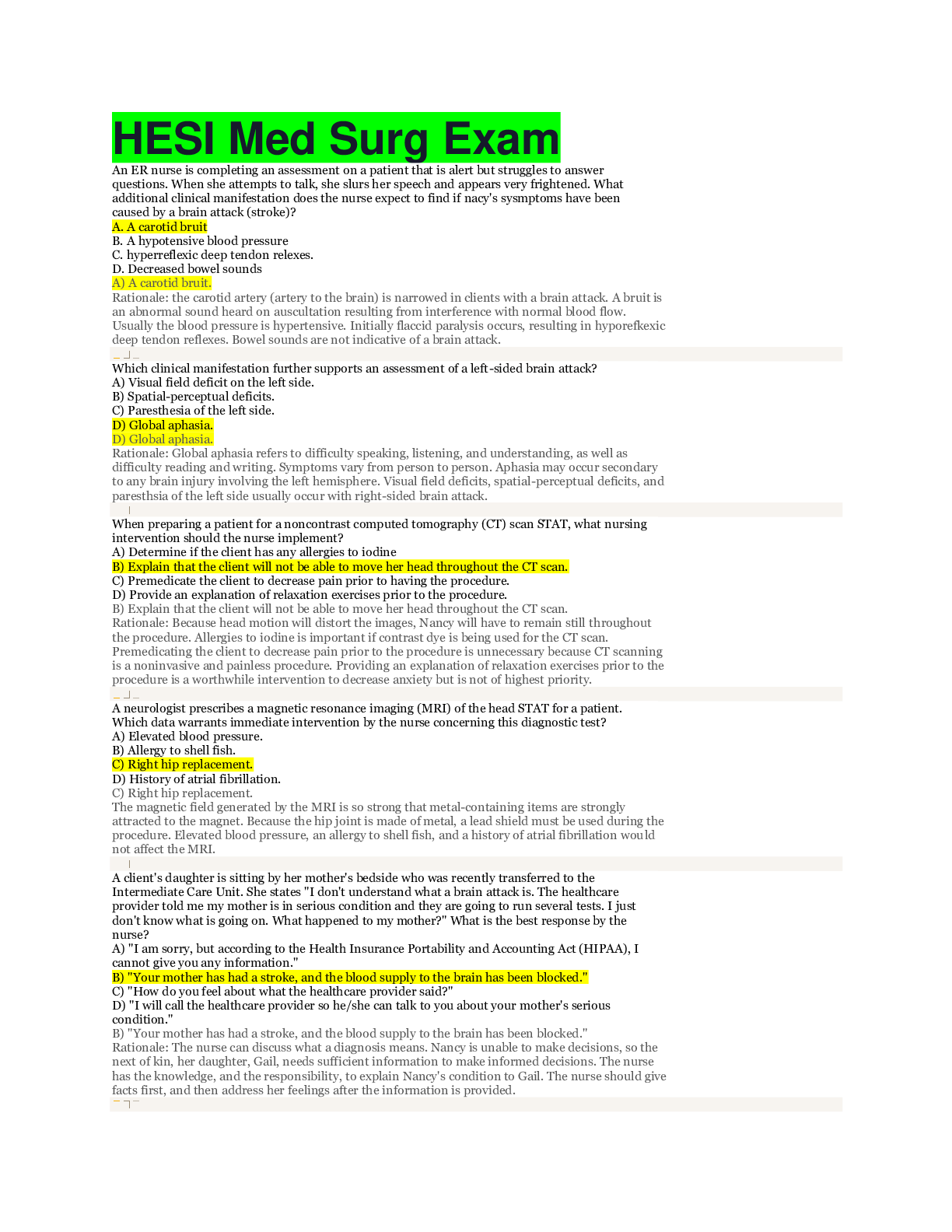
Reviews( 1 )

by simransingh · 3 years ago
Document information
Connected school, study & course
About the document
Uploaded On
Jun 21, 2020
Number of pages
28
Written in
Additional information
This document has been written for:
Uploaded
Jun 21, 2020
Downloads
19
Views
1776

